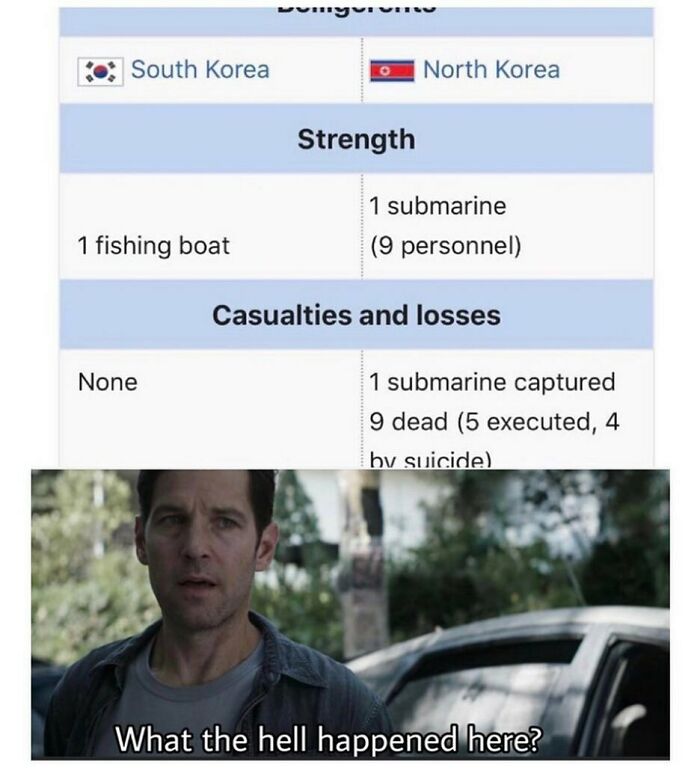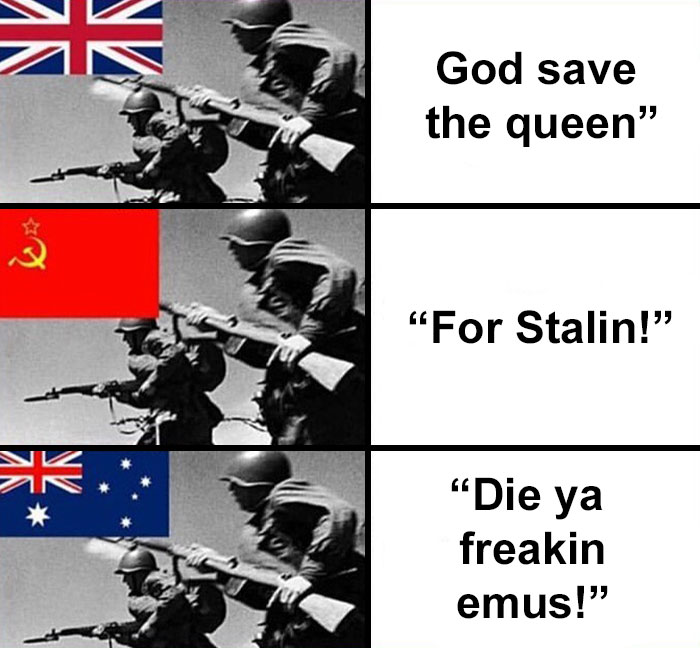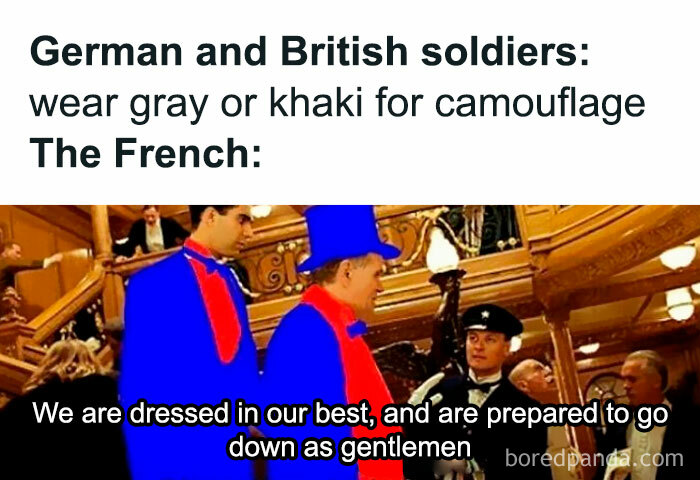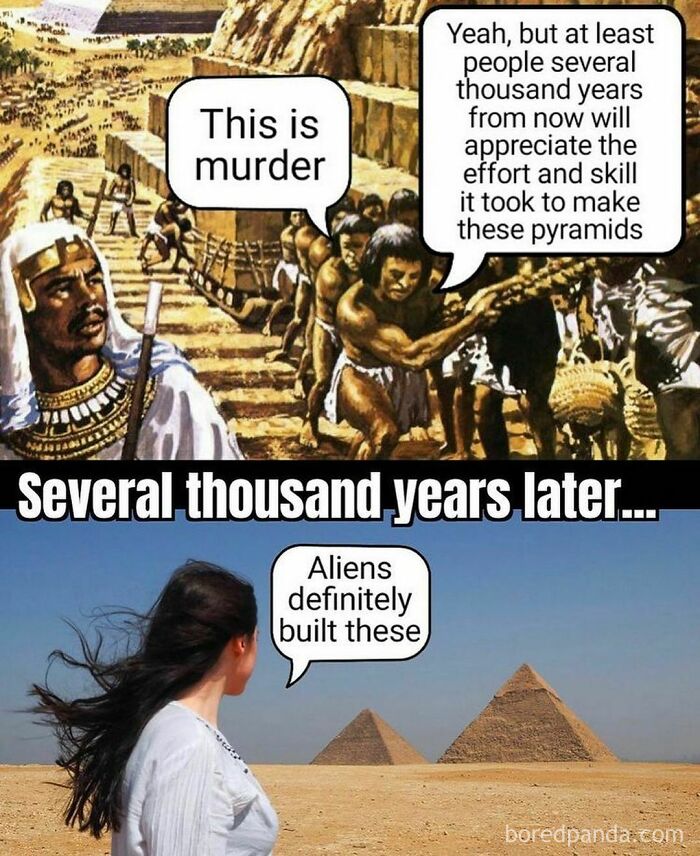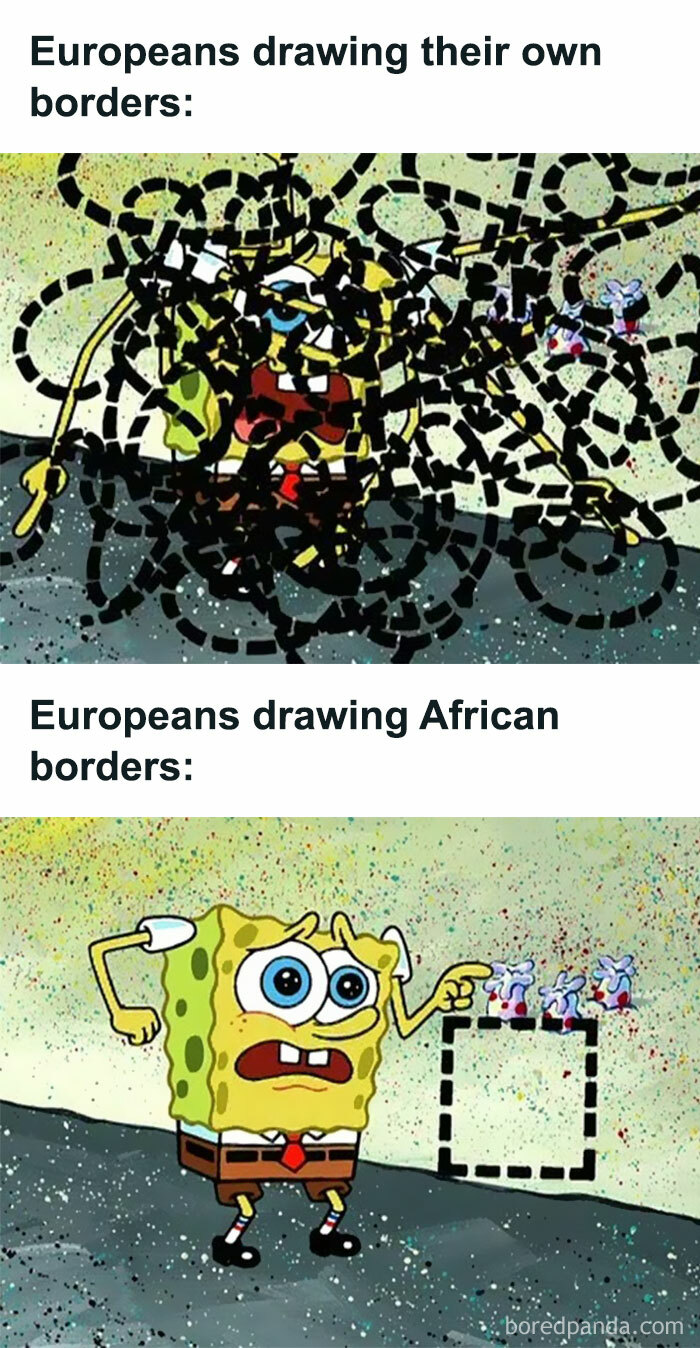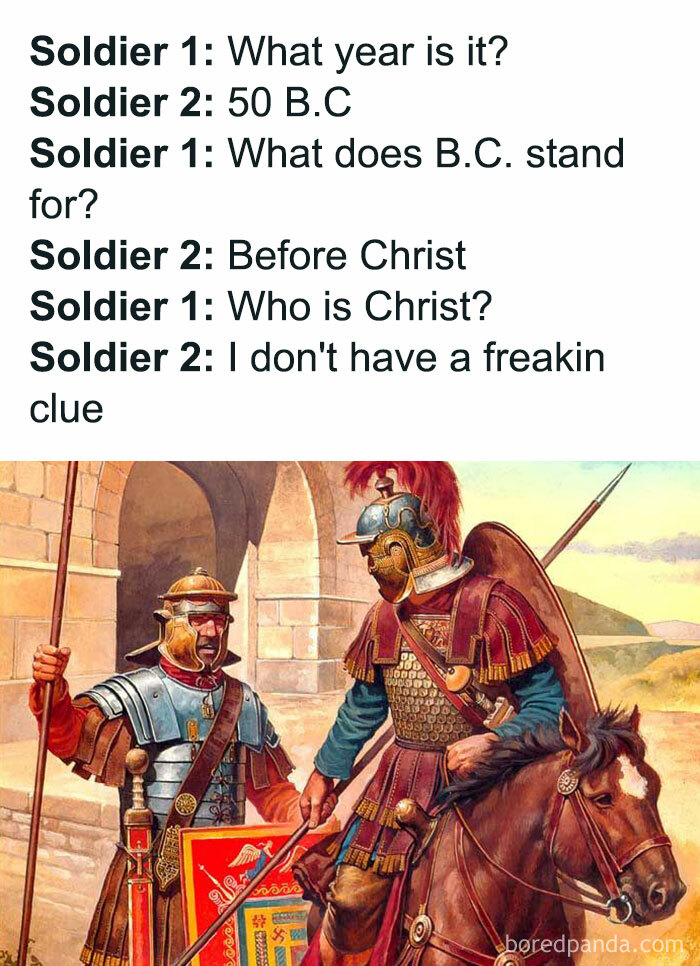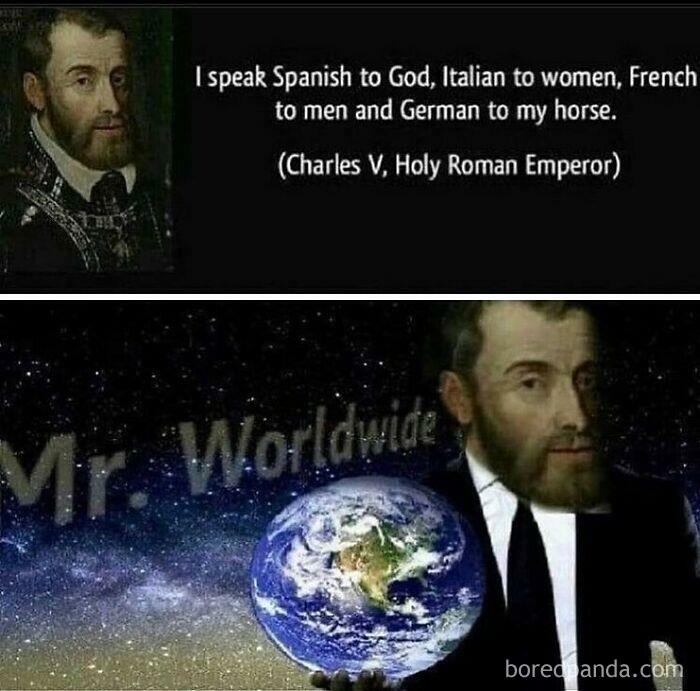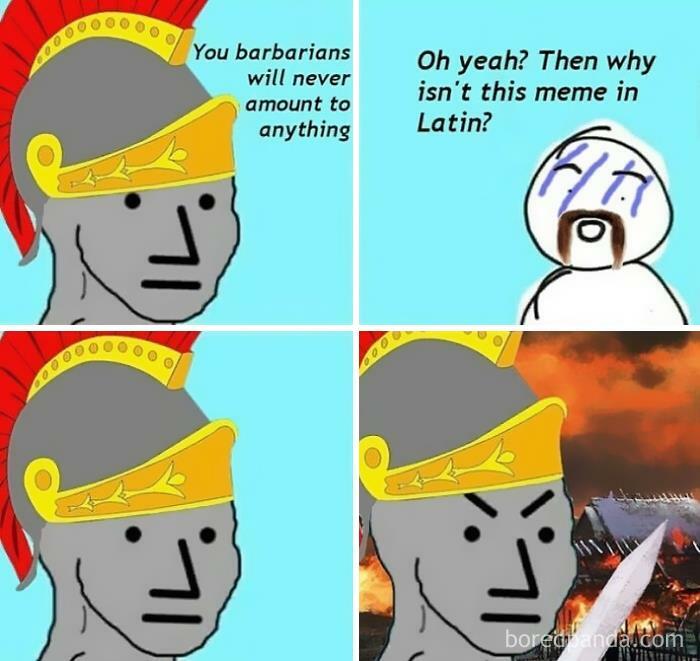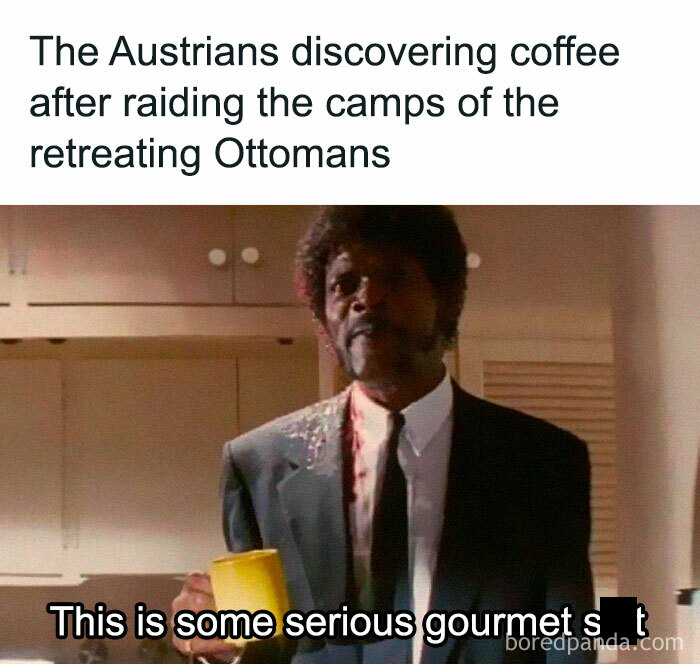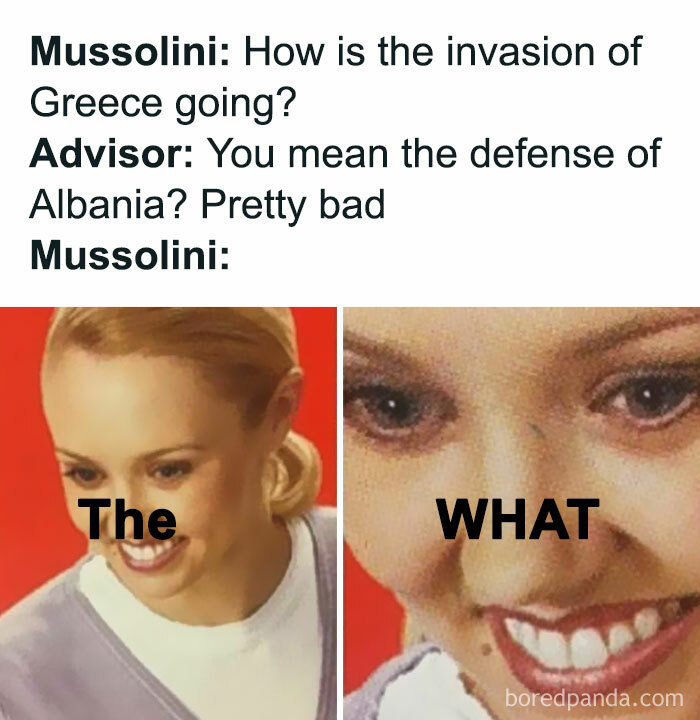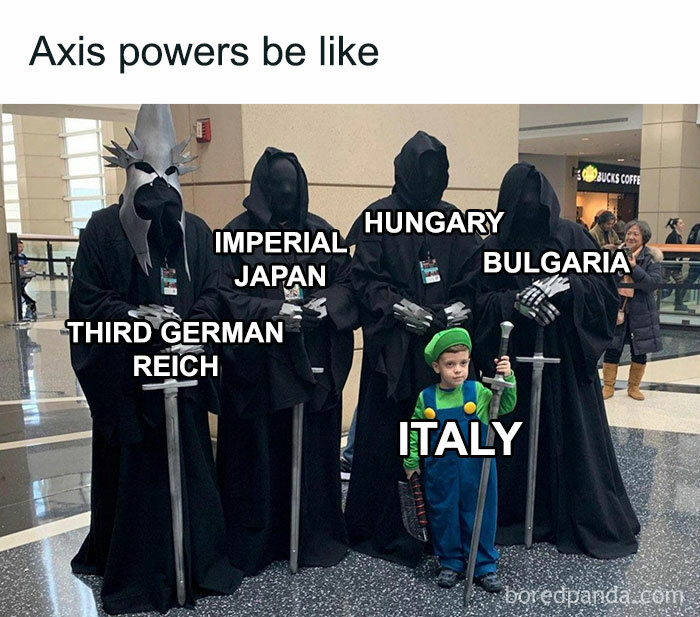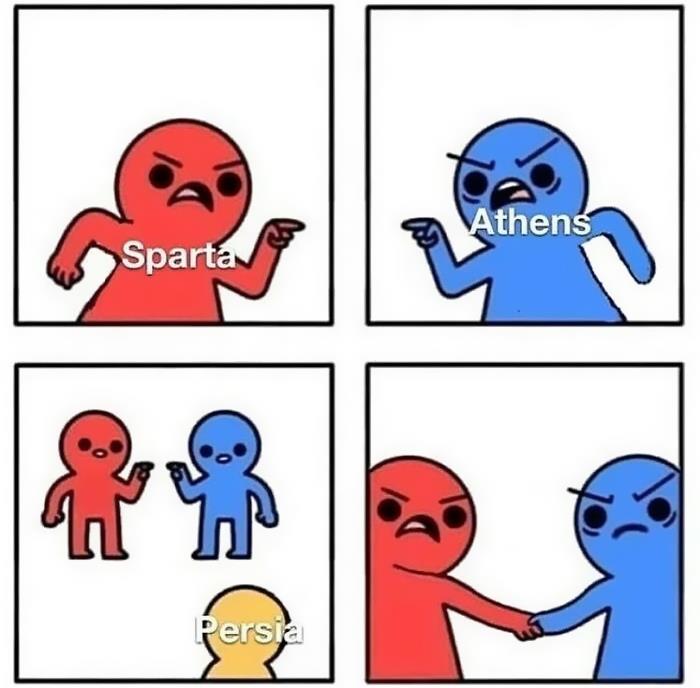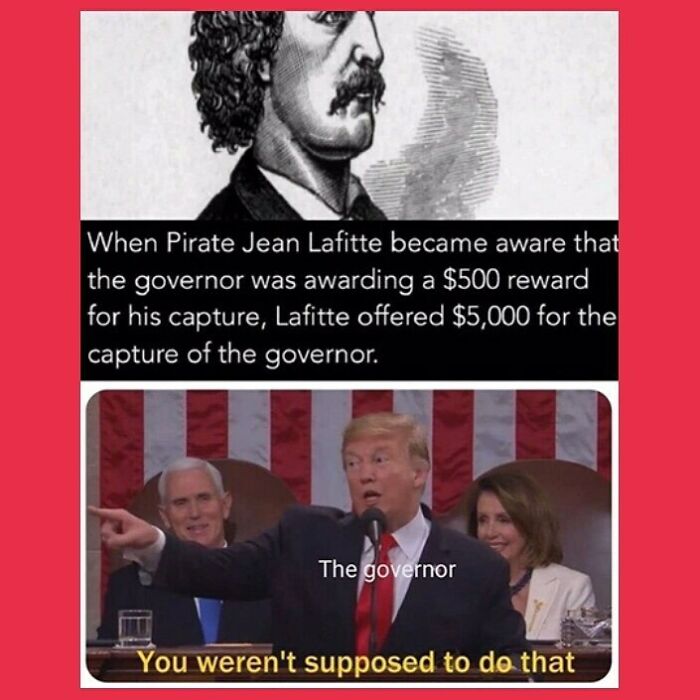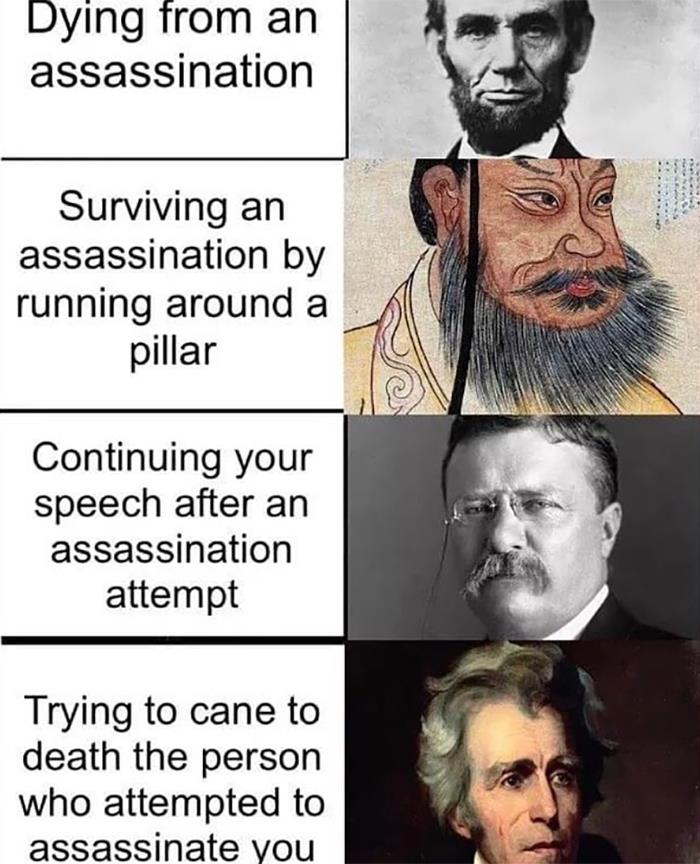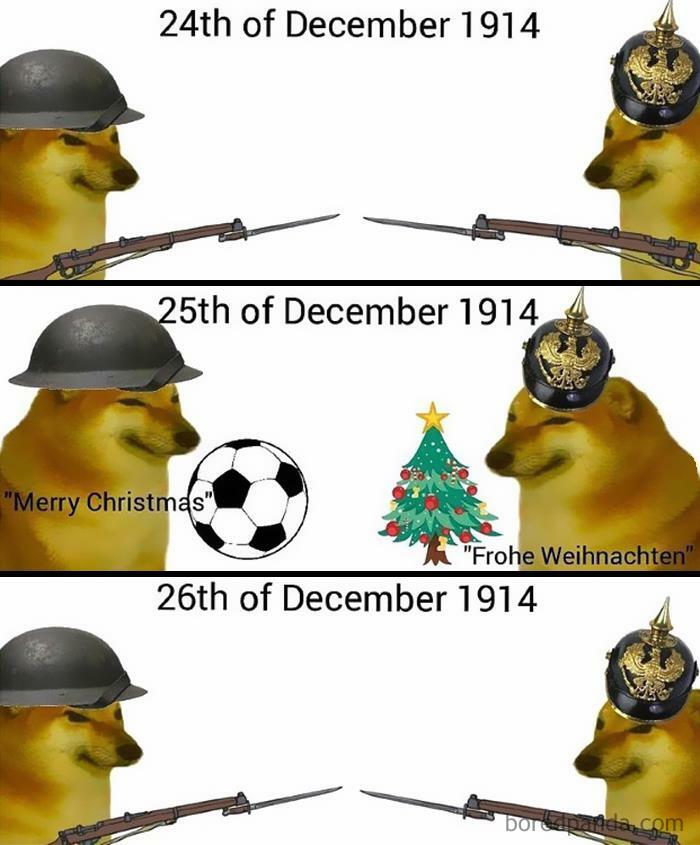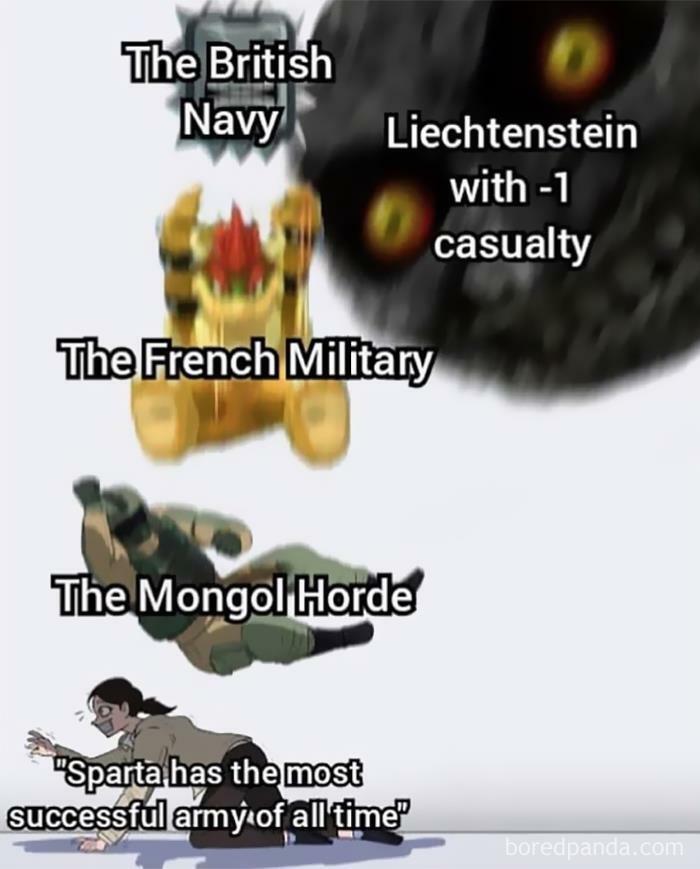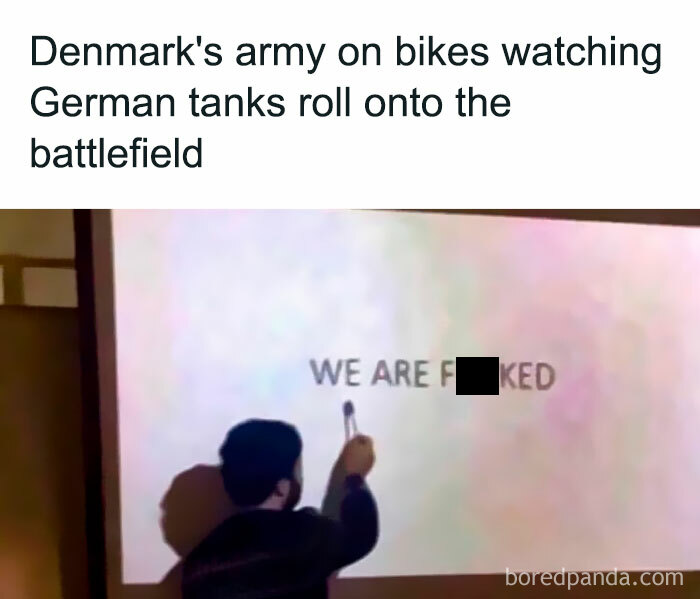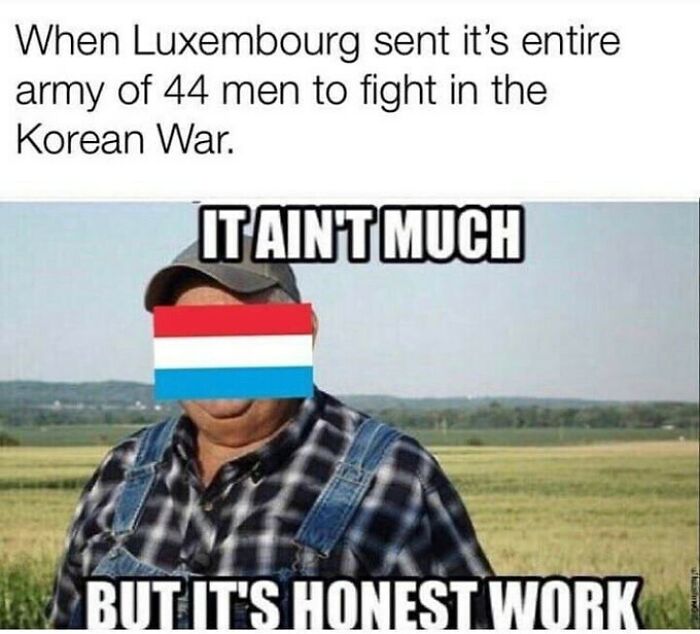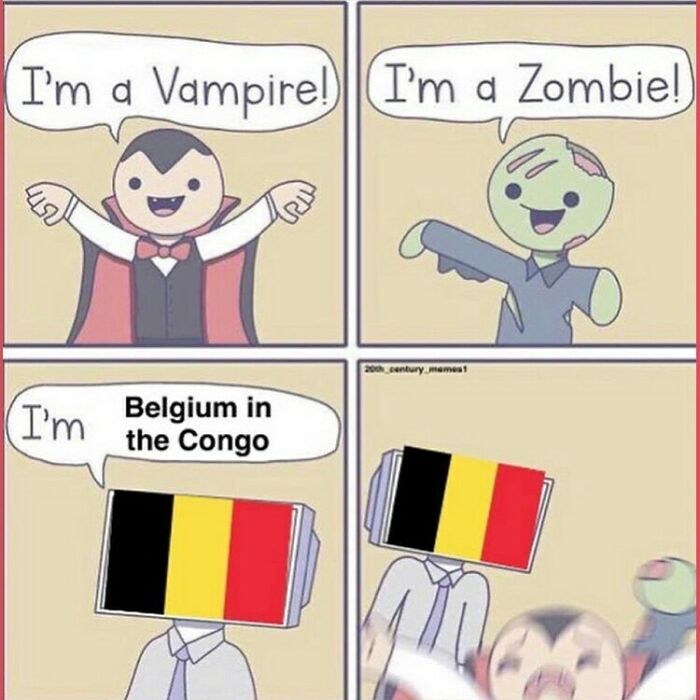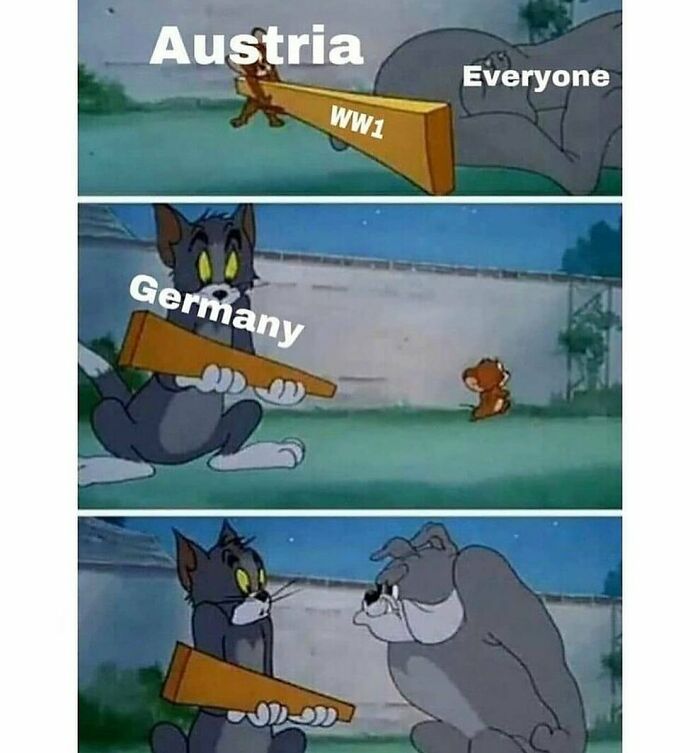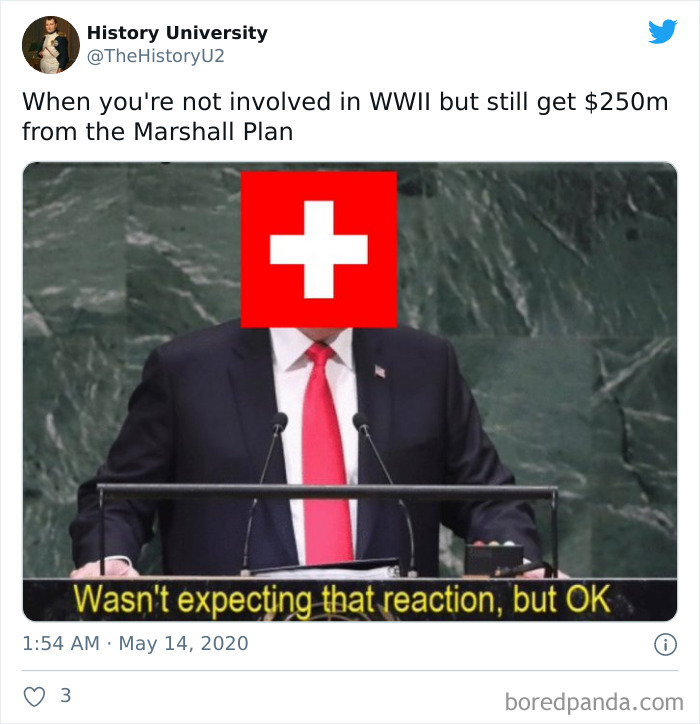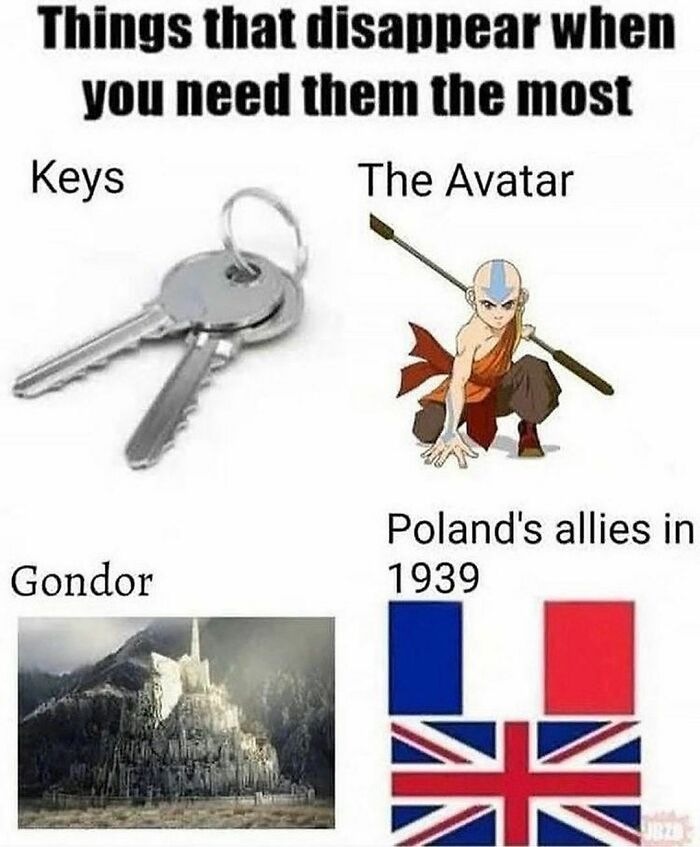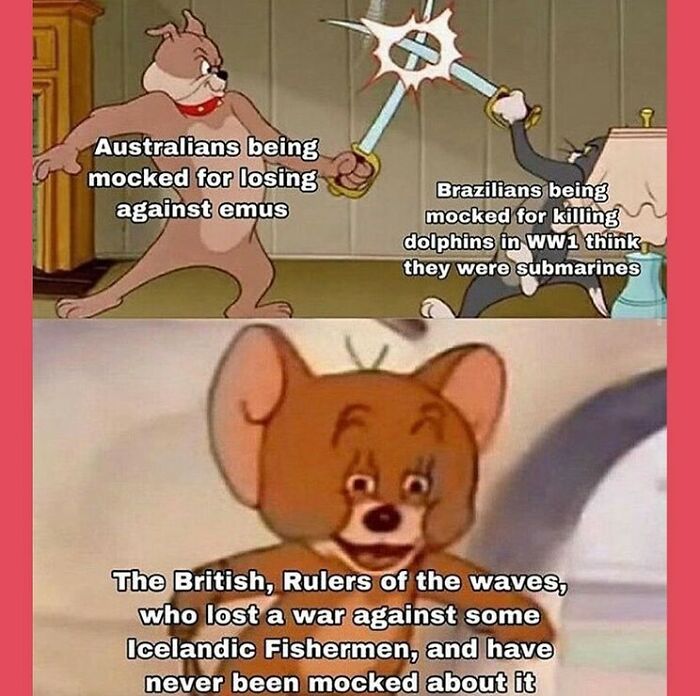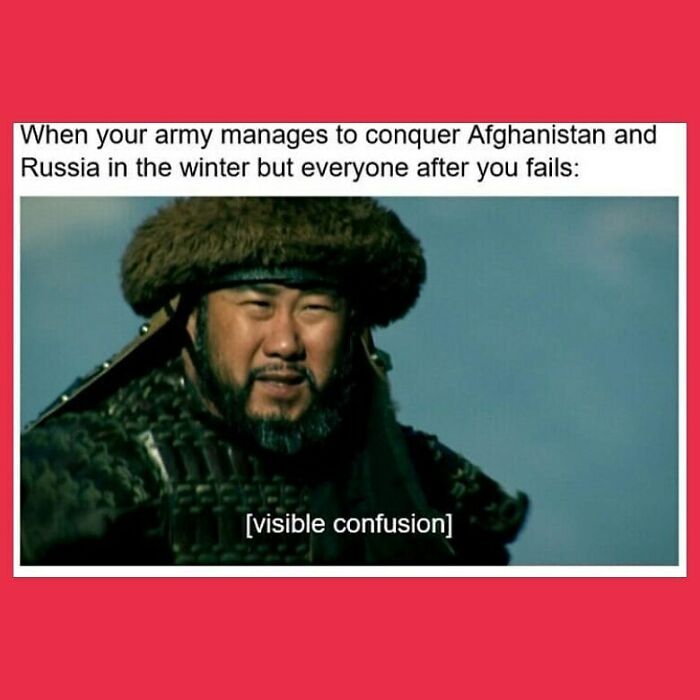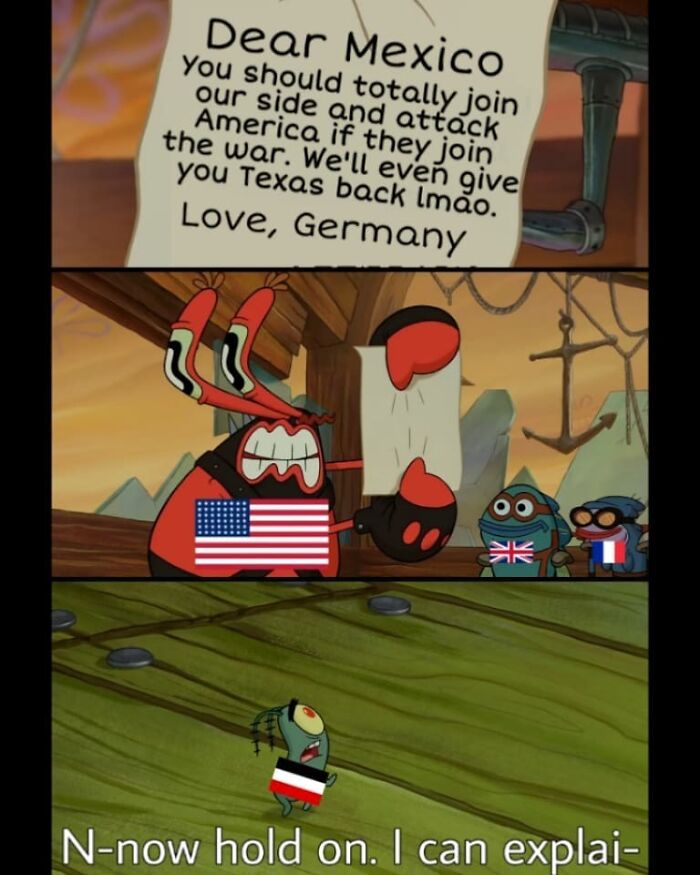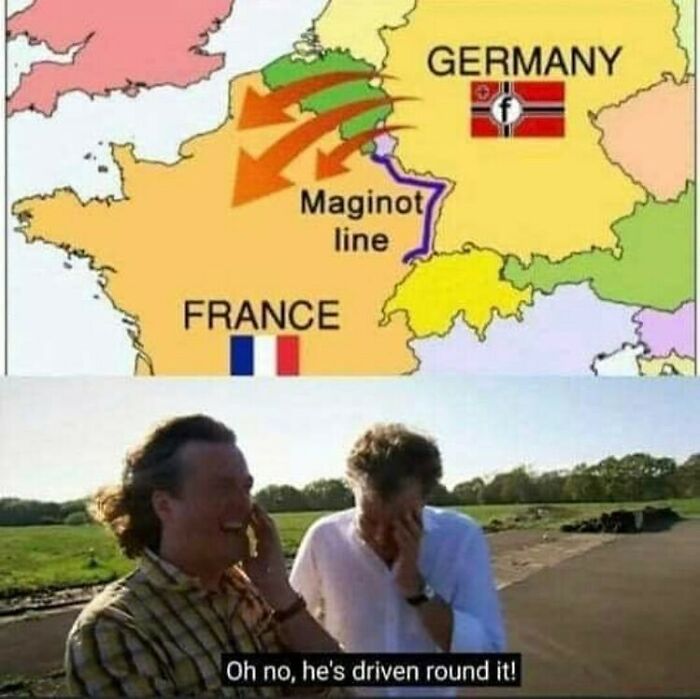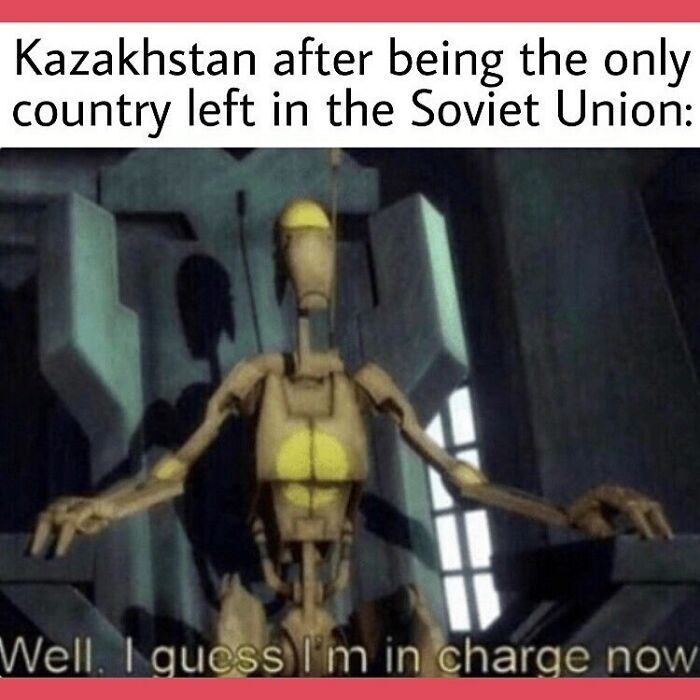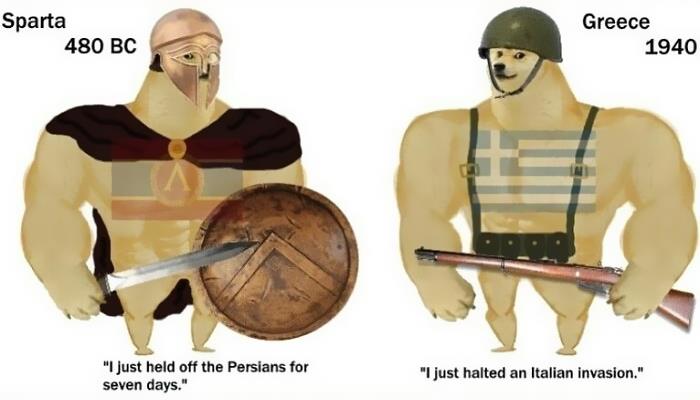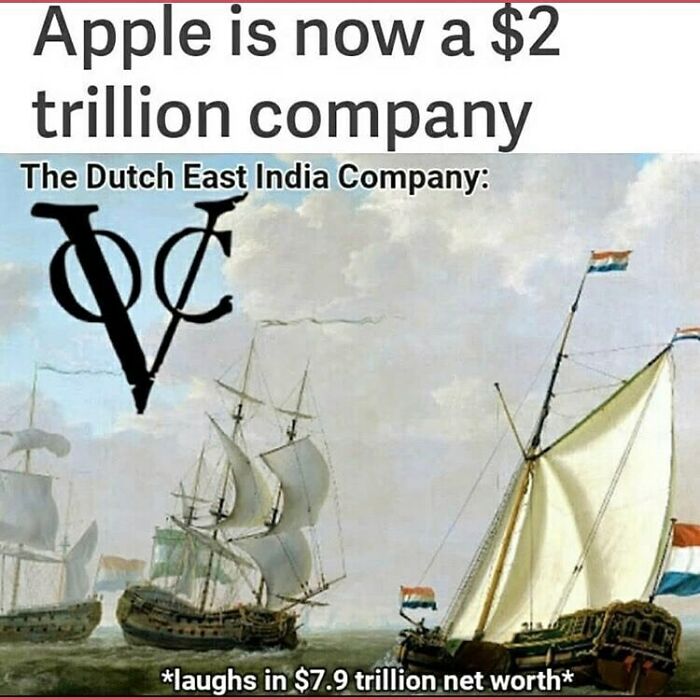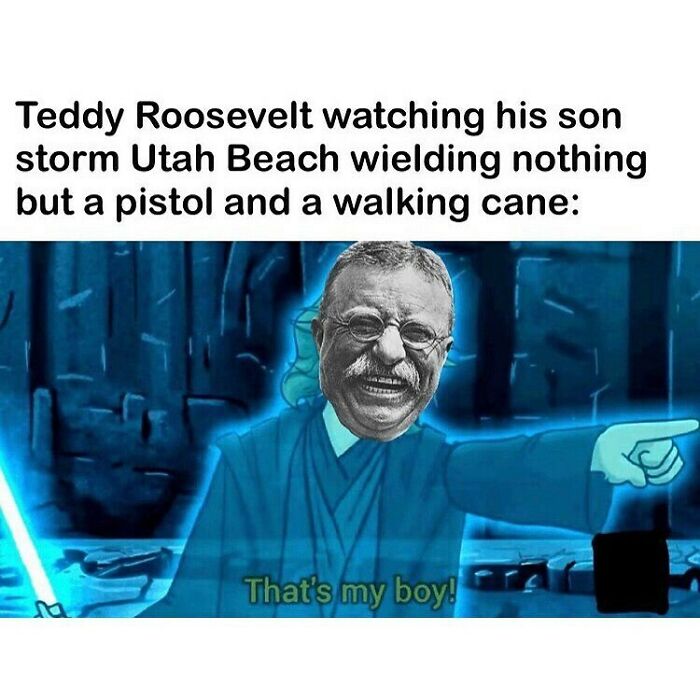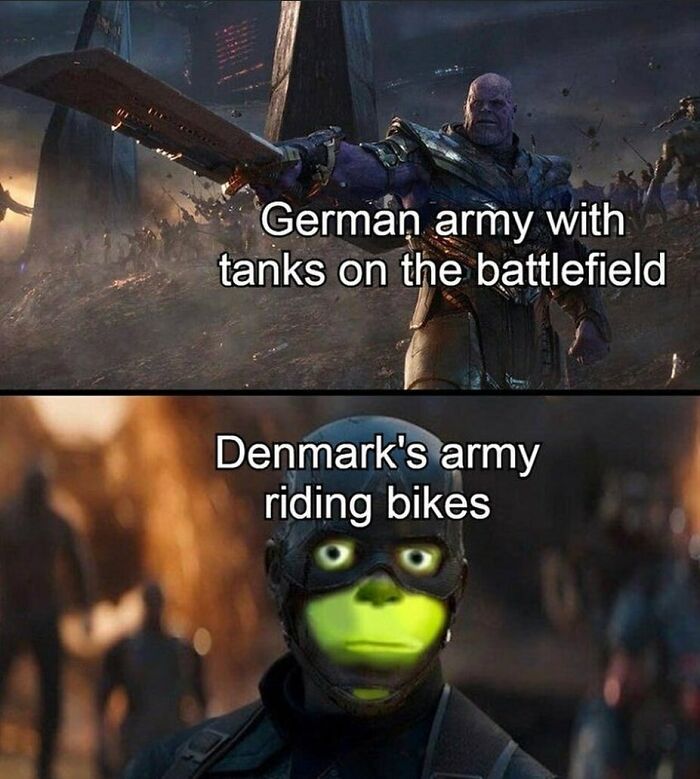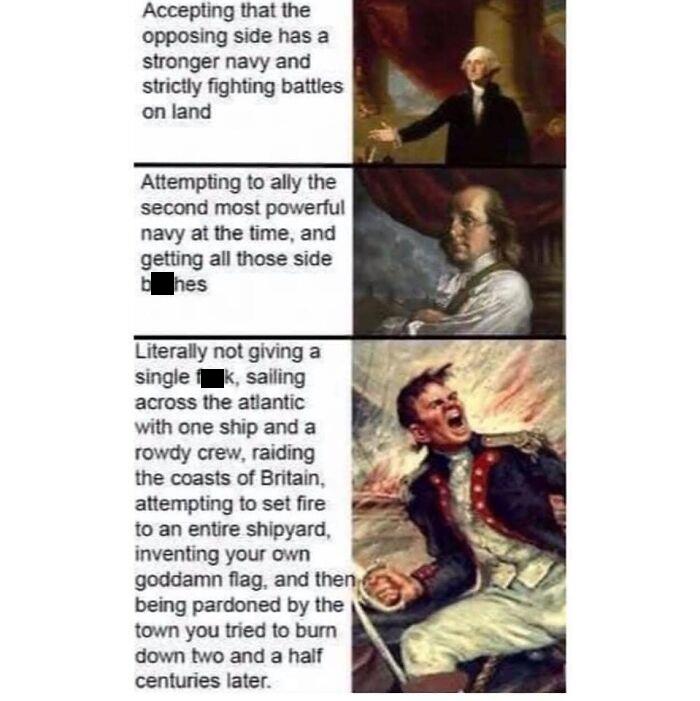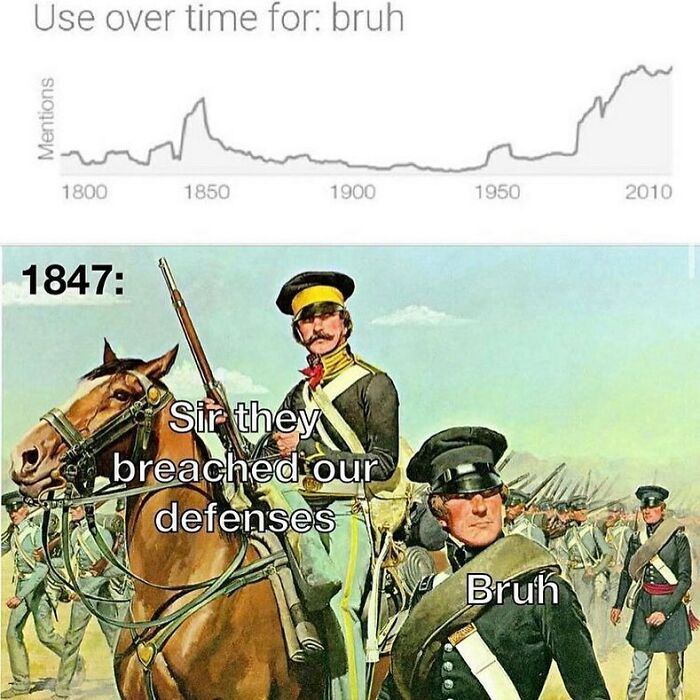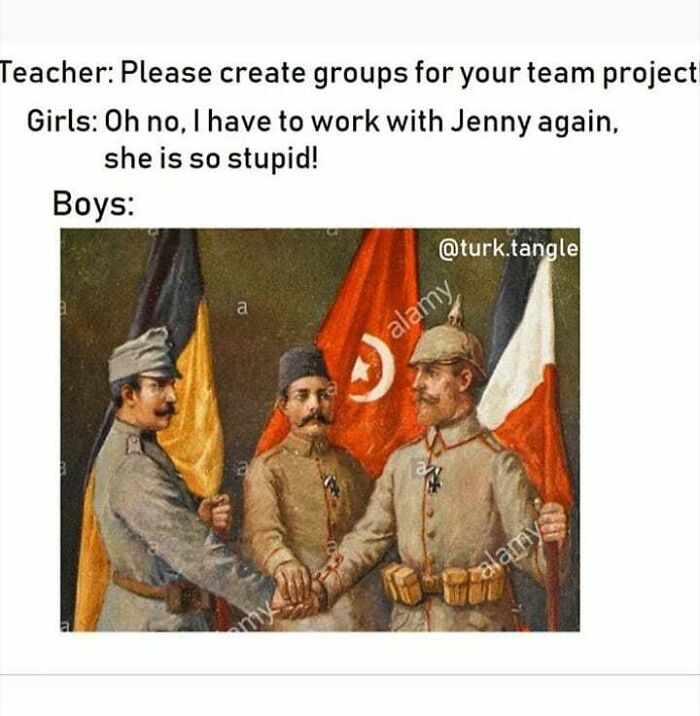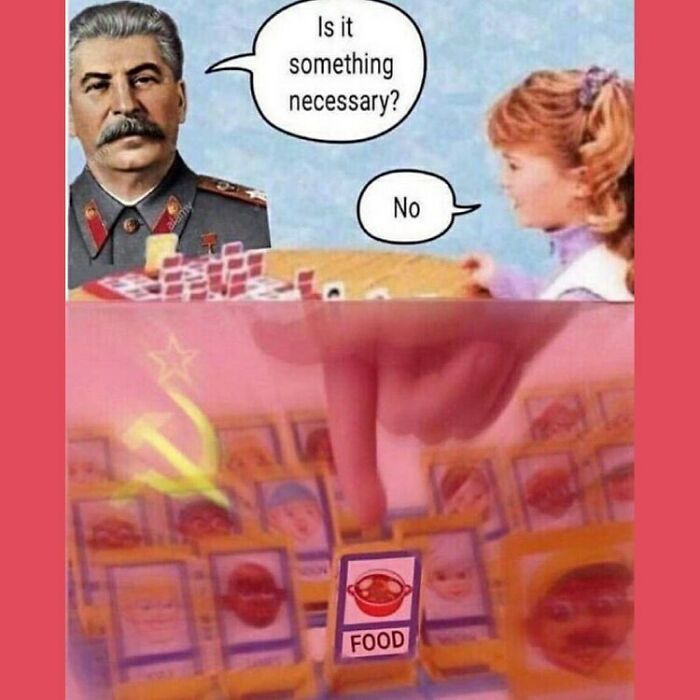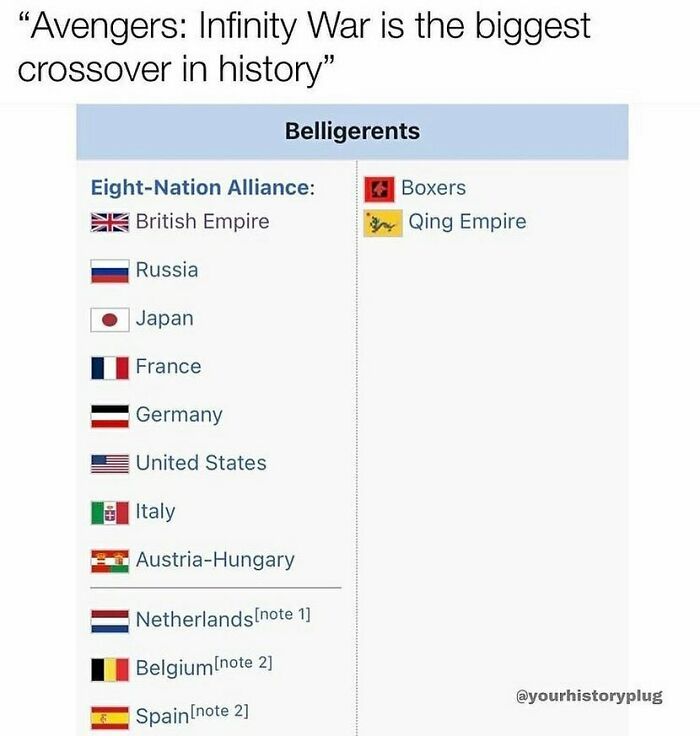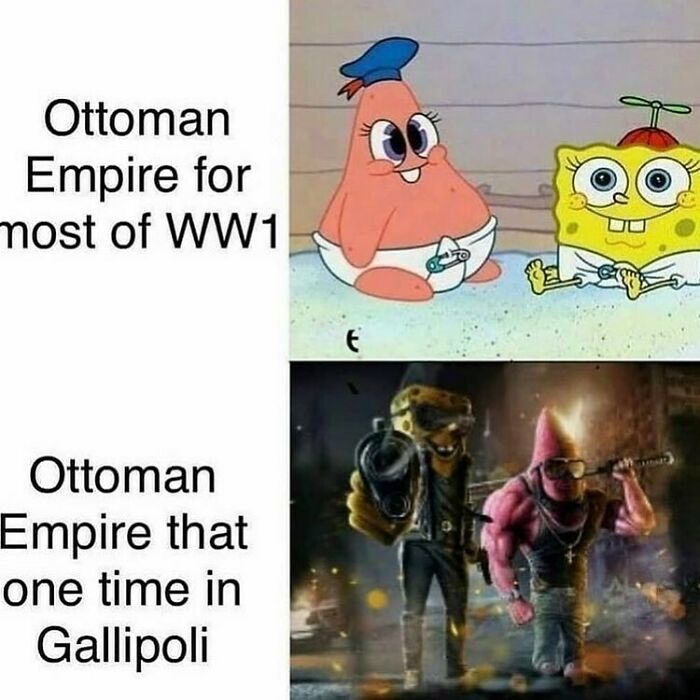
This Instagram Account Educates People By Explaining The Best History Memes Out There (30 Pics)
If history textbooks were more like this Instagram account, maybe more kids would open them. Or at least try to.
History Memes Explained is a social media project with a simple mission: to collect and dissect the best memes about our past.
From famous figures and funny maps to cold-hearted betrayals and memorable battles, History Memes Explained has a little something for everyone, and the pictures are as amusing as the explanations are educational.
Continue scrolling and check out some of its most popular posts.
More info: Instagram
This post may include affiliate links.
The Bank of England is one of the oldest financial institutions in the world, tasked with maintaining monetary stability in the United Kingdom. Since 1734 it has occupied a 3.4-acre site in London's Threadneedle Street, where the iconic building conceals eight subterranean vaults filled with gold. The bank prides itself on having never been robbed at any point in its 325-year history. However, it is rumored that the bank's defenses were actually breached in the 19th century when an enterprising sewer worker managed to gain access to the main gold vault. According to the bank's website, this incredible incident was the source of considerable embarrassment to its venerable, Victorian directors.
In 1836, the directors of the Bank of England received an anonymous letter, in which the author claimed to have direct access to the gold in the bank. The directors assumed this to be a joke and simply ignored it. However, sometime later, they received another letter, in which the enigmatic author offered to meet them at an hour of their choosing inside the main gold vault. According to the bank's website, the directors were intrigued but considered it impossible for someone to break into the vault without their knowledge. Nevertheless, they agreed to the meeting and gathered together one evening, inside the vault as agreed. To their great surprise, at the appointed time, a noise was heard beneath the floorboards, and a man popped up underneath their feet.
He was a sewer worker who had been working on repairs close to the Bank of England site at Threadneedle Street. During his routine inspection, he had discovered an old drain that led directly underneath the gold vault inside the bank itself. The drain provided an ideal access point to the gold vault, and constituted a major security breach. The directors of the bank were aghast at the discovery of such a significant hole in their carefully constructed security arrangements. They realized that the sewer worker had not taken anything from the vault, despite having multiple opportunities to do so. As a reward for his honesty, the directors gifted him £800, a sum that equates to £80,000 in today’s money and which would have surely transformed the man’s life.
The person behind History Memes Explained is Cole Crosby, a 17-year-old high-school student. "History and entrepreneurship have always been a passion of mine," Cole told Bored Panda. "I feel very lucky to run an Instagram page that combines these two things."
He said the genesis for History Memes Explained came out of boredom. "Like many young students, I had long been aware of social media influencers and YouTubers. I had actually attempted to become an influencer twice before, once with a gaming YouTube channel and the other time with a political Instagram page. Neither project went anywhere."
"In the summer of 2019, the idea of creating a history-themed meme page came to me as I was sitting at home bored; with nothing better to do, I made it a reality."
Writing in his book Creativity Inc, Pixar co-founder Ed Catmull recalled that in the winter of 1998, a year out from the release of Toy Story 2, somebody (he never reveals who in the book) entered a computer command on the drives where the film's files were kept. The object of said command is to remove everything from a given location, and to remove it quickly. It did its job. "First, Woody's hat disappeared. Then his boots. Then he disappeared entirely," recalls Catmull. "Whole sequences—poof!—were deleted from the drive." One of the film's technical directors, Oren Jacobs, watched it all happen in real time. His call to systems support started with him telling them to “pull out the plug on the Toy Story 2 master machine." When asked why by the person on the other end of the phone (a not-unreasonable question), Jacobs screamed “Please, God, just pull it out as fast as you can.”
The plug was pulled, but not in time—90% of the film was gone, erased "in a matter of seconds." And it got worse. A plan was quickly hatched to restore the data from a regular backup, which meant that only half a day of work would have been lost. But the backup system had failed. Pixar, incredibly, did not have a copy of the Toy Story 2 files on its servers. "To reassemble the film would have taken thirty people a solid year," Catmull recalled. Toy Story 2 looked doomed. Yet it was saved by something akin to blind luck. Galyn Susman was Toy Story 2's supervising technical director, and after she'd given birth to her second child, she'd been working from home. As such, once a week, she'd taken an entire copy of the film home with her.
A minute later, she was zooming home. Her computer was wrapped in blankets and put on the backseat of her car ("carefully"). In Oren's words, the computer was then "carried into Pixar like an Egyptian pharaoh." While work had been lost, Susman's backup files limited the damage significantly. Furthermore, given the size of Pixar at the time—which was still years away from being the company big enough to merge with Disney—her computer may just have saved the firm (at least in the form that we know it). Unsurprisingly, Pixar put into place processes that stopped this ever happening again. And, crucially, Toy Story 2 just about made its deadline.
If one believes in omens, there were a number of reasons for Caesar not to attend the Senate meeting that day. First, Caesar’s horses that were grazing on the banks of the Rubicon were seen to weep. Next, a bird flew into the Theater of Pompey with a sprig of laurel but was quickly devoured by a larger bird. Caesar’s wife, Calpurnia had a dream of him bleeding to death in her arms. And lastly, a soothsayer named Spurinna warned him to beware of danger no later than the Ides of March. Unfortunately, Caesar put little faith in omens. A large crowd accompanied Caesar on his way to the Senate. Just as he entered the theater a man named Artemidorus tried to warn him of eminent danger by thrusting a small scroll into his hand, but Caesar ignored it. The dictator entered and sat on his throne. Cimber approached the unsuspecting Caesar and handed him a petition on behalf of his exiled brother; Caesar, of course, did not rise to greet him. Cimber grabbed at Caesar’s toga and pulled it back. Caesar reportedly said, “Why, this is violence?” Casca dealt the first blow with his knife; Caesar immediately tried to defend himself by raising his hands to cover his face. The remaining conspirators surrounded the shocked Caesar - Cassius struck him in the face, Decimus to the ribs. Caesar collapsed, dead, ironically at the foot of a statue of his old enemy Pompey. In all there were twenty-three blows. Despite the beautiful words of William Shakespeare Caesar did not say “E tu, Brute!” (You, too, Brutus!) as Brutus plunged his dagger into the dying dictator but “You, too, my child!”
According to Crosby, this early bird version of History Memes Explained was very different from how it is —he only posted memes. The idea to actually explain them came a year later. "For much of this early time, my page wasn't that successful," Cole recalled. "I was posting every day and barely growing. My big break came when I added the explanations."
"To be honest, it was pretty much a moment of sudden clarity. The idea to explain the memes just came to me. But when I started doing so, my page exploded. Soon, I was gaining 600, even 800 followers every day. I adopted a very aggressive posting strategy, making two high-quality posts every day." Since then, Cole has slowed down slightly, but he still tries to post a meme and an explanation every day.
He himself views History Memes Explained as a place that truly makes learning fun. "I post funny memes about historical topics and then do a deep dive into the [facts] behind the meme, uncovering and explaining important, obscure, or just downright interesting parts of history in an entertaining format."
US President Bill Clinton and Russian President Boris Yeltsin had a weird relationship. There was the time the Russian president gave the U.S. president a pair of hockey jerseys that said “Yeltsin 96" and “Clinton 96.” There was also the time Clinton doubled over laughing when Yeltsin called the U.S. press “a disaster” at a press conference. But perhaps the weirdest incident in their professional relationship was when Yeltsin got drunk and wandered into the street in his underwear, trying to get a pizza. The incident happened during Yeltsin and Clinton's first meeting in Washington in September 1994.
Although there were glancing media reports about it over the years, it wasn’t widely reported on until 2009, when author Taylor Branch published his book The Clinton Tapes, based on his interviews with the president. “Secret Service agents discovered Yeltsin alone on Pennsylvania Avenue, dead drunk, clad in his underwear, yelling for a taxi," Branch wrote in his book. “Yeltsin slurred his words in a loud argument with the baffled agents. He did not want to go back into Blair House, where he was staying. He wanted a taxi to go out for pizza.” When Branch asked Clinton how the situation ended, the president shrugged and said, “Well, he got his pizza.” Yeltsin was carefully escorted back to Blair House, the traditional residence for visiting heads of state in Washington, by the Secret Service.
In 1998, a North Korean submarine became entangled in a fishing net in South Korean waters. A South Korean fishing boat observed the crew trying to untangle the submarine from the fishing net. The fishing boat notified the South Korean Navy, who towed the submarine with the crew still inside to a nearby navy base. The submarine sank as it was being towed into port, it was unclear if this was as a result of damage or a deliberate scuttling by the crew. On 25 June the submarine was salvaged from a depth of approximately 100 feet and the bodies of 9 crewmen were recovered, 5 sailors had apparently been murdered while 4 agents had apparently committed suicide. The presence of South Korean drinks suggested that the crew had completed an espionage mission. Log books found in the submarine showed that it had infiltrated South Korean waters on a number of previous occasions.
This juxtaposition of the meaningful and the silly reminds me of all the classical art memes that have been going around the Internet. Maybe it's about time we take the "important stuff" off the pedestal and make it accessible to the youth as freely as everything else online? Who cares about the form when the content is rich.
At first, Cole spent a lot of time looking for the right memes, after all, it's all about striking the right balance. "I need memes about topics that were well known enough to resonate with my audience, but still obscure enough to warrant an explanation."
"In the early days, I often just made the memes myself from scratch," he said. "As I've become successful, however, this has changed. Now, I receive dozens of messages from my followers every week. Most of these have meme submissions, that my followers would like me to explain. Currently, this is where I get most of my memes from," the student said.
Slavery in ancient Rome differed from its modern forms in that it was not based on race. But like modern slavery, it was an abusive and degrading institution. Cruelty was commonplace. Slavery had a long history in the ancient world and was practiced in Ancient Egypt and Greece, as well as Rome. Slaves in Rome might include prisoners of war, sailors captured and sold by pirates, or slaves bought outside Roman territory. In hard times, it was not uncommon for desperate Roman citizens to raise money by selling their children into slavery. All slaves and their families were the property of their owners, who could sell or rent them out at any time. Their lives were harsh. Slaves were often whipped, branded or cruelly mistreated. Their owners could also kill them for any reason, and would face no punishment. Although Romans accepted slavery as the norm, some people - like the poet and philosopher, Seneca - argued that slaves should at least be treated fairly.
Slaves worked everywhere - in private households, in mines and factories, and on farms. They also worked for city governments on engineering projects such as roads, aqueducts and buildings. As a result, they merged easily into the population. In fact, slaves looked so similar to Roman citizens that the Senate once considered a plan to make them wear special clothing so that they could be identified at a glance. The idea was rejected because the Senate feared that, if slaves saw how many of them were working in Rome, they might be tempted to join forces and rebel. Another difference between Roman slavery and its more modern variety was manumission - the ability of slaves to be freed. Roman owners freed their slaves in considerable numbers: some freed them outright, while others allowed them to buy their own freedom.
The prospect of possible freedom through manumission encouraged most slaves to be obedient and hard working. Formal manumission was performed by a magistrate and gave freed men full Roman citizenship. The one exception was that they were not allowed to hold office. However, the law gave any children born to freedmen, after formal manumission, full rights of citizenship, including the right to hold office. Informal manumission gave fewer rights. Slaves freed informally did not become citizens and any property or wealth they accumulated reverted to their former owners when they died. Once freed, former slaves could work in the same jobs as plebeians - as craftsmen, midwives or traders. Some even became wealthy. However, Rome's rigid society attached importance to social status and even successful freedmen usually found the stigma of slavery hard to overcome - the degradation lasted well beyond the slavery itself.
The Emu War was a military operation undertaken in Australia over the latter part of 1932 to address public concern over the number of emus said to be running amok in the Campion district of Western Australia. The unsuccessful attempts to curb the population of emus, a large flightless bird indigenous to Australia, employed soldiers armed with Lewis guns—leading the media to adopt the name "Emu War" when referring to the incident. While a number of the birds were killed, the emu population persisted and continued to cause crop destruction.
The 'war' was conducted under the command of Major G.P.W. Meredith of the Seventh Heavy Battery of the Royal Australian Artillery, with Meredith commanding soldiers Sergeant S. McMurray and Gunner J. O'Hallora, armed with two Lewis guns and 10,000 rounds of ammunition.The operation was delayed, however, by a period of rainfall that caused the emus to scatter over a wider area.The rain ceased by 2 November 1932, at which point the troops were deployed with orders to assist the farmers. However, a series of technical problems, combined with the Emu's superior maneuverability and ability to sustain multiple bullets, meant that the efforts were largely unsuccessful, and no significant impact was made on the population of the birds. Meredith would go on to state that "Emus can face machine guns with the invulnerability of tanks. They are like Zulus whom even dum-dum bullets could not stop."
Having looked at so, so many history memes, Cole remains a little uncertain when it comes to determining what is "in."
"Of course, you get the big events that are very popular topics like World War 2, but you also get a few smaller topics that for some reason are very popular with the community, such as the 1932 'war' that Australia fought against Emu birds. Controversial memes also seem to do well."
He thinks the Instagram algorithm favors content that generates controversy and thus a lot of comments, so he tries to keep his project as unbiased and historically accurate as possible. That being said, the guy isn't afraid to poke fun at historical figures and events. And it appears to be working—History Memes Explained already has 169K followers.
At the outbreak of World War 1, the French Army retained the colourful traditional uniforms of the nineteenth century for active service wear. These included conspicuous features such as blue coats and red trousers for the infantry and cavalry. The French cuirassiers wore plumed helmets and breastplates almost unchanged from the Napoleonic period.
From 1903 on several attempts had been made to introduce a more practical field dress but these had been opposed by conservative opinion both within the army and amongst the public at large. In particular, the red trousers worn by the infantry became a political debating point.
Adolphe Messimy who was briefly Minister of War in 1911-1912 stated that "This stupid blind attachment to the most visible of colours will have cruel consequences"; however, in the following year, one of his successors, Eugène Étienne, declared "Abolish red trousers? Never!" The very heavy French losses during the Battle of the Frontiers can be attributed in part to the high visibility of the French uniforms, combined with peacetime training which placed emphasis on attacking in massed formations.
The shortcomings of the uniforms were quickly realized and during the first quarter of 1915 general distribution of horizon-blue clothing in simplified patterns had been undertaken.
These were "Gentlemen war" outfits. Camouflage and green/grey colors were seen as cowardliness. From this era point of view, you were supposed to see you enemy, and fight him with honor, not hide and hit from the shadows.
Chinese troops storm through Tiananmen Square in the center of Beijing, killing and arresting thousands of pro-democracy protesters. The brutal Chinese government assault on the protesters shocked the West and brought denunciations and sanctions from the United States. In May 1989, nearly a million Chinese, mostly young students, crowded into central Beijing to protest for greater democracy and call for the resignations of Chinese Communist Party leaders deemed too repressive. For nearly three weeks, the protesters kept up daily vigils, and marched and chanted. Western reporters captured much of the drama for television and newspaper audiences in the United States and Europe.
Turmoil ensued, as tens of thousands of the young students tried to escape the rampaging Chinese forces. Other protesters fought back, stoning the attacking troops and overturning and setting fire to military vehicles. Reporters and Western diplomats on the scene estimated that at least 300, and perhaps thousands, of the protesters had been killed and as many as 10,000 were arrested. The savagery of the Chinese government's attack shocked both its allies and Cold War enemies. Soviet leader Mikhail Gorbachev declared that he was saddened by the events in China. In the United States, editorialists and members of Congress denounced the Tiananmen Square massacre and pressed for President George Bush to punish the Chinese government. A little more than three weeks later, the U.S. Congress voted to impose economic sanctions against the People’s Republic of China in response to the brutal violation of human rights.
The man should be disappeared too. We never learned his actual identity and his whereabouts are unknown. I'll let you speculate why
If you ask people to name the victorious Allied Powers in World War II, Mexico isn't usually a name that comes to mind. But after declaring war against the Axis in mid-1942, Mexico did contribute to the Allied victory in important ways. Despite long standing tensions with the United States, Mexico would become a valuable ally to its northern neighbor, ramping up its industrial production and contributing vital resources to the Allied war effort. In addition, thousands of Mexican nationals living in the United States registered for military service during World War II. Mexico's own elite air squadron, known as the Aztec Eagles, flew dozens of missions alongside the U.S. Air Force during the liberation of the Philippines in 1945.
The Aztec Eagles (including 33 pilots and more than 270 support personnel) arrived in Manila Bay in the Philippines on April 30, 1945. Over the next few months, they flew 795 combat sorties and logged almost 2,000 hours of flying time, including conducting bombing missions over Luzon and Formosa and providing support for U.S. airmen. Seven pilots from Squadron 201 died in the conflict; the surviving members returned to a heroes’ welcome in Mexico after Japan’s surrender. The squadron played an important symbolic role, inspiring national and cultural pride among Mexicans at home and helping to keep them invested in the war effort.
Though some popular versions of history held that the pyramids were built by slaves or foreigners forced into labor, skeletons excavated from the area show that the workers were probably native Egyptian agricultural laborers who worked on the pyramids during the time of year when the Nile River flooded much of the land nearby. Approximately 2.3 million blocks of stone (averaging about 2.5 tons each) had to be cut, transported and assembled to build Khufu's Great Pyramid. The ancient Greek historian Herodotus wrote that it took 20 years to build and required the labor of 100,000 men, but later archaeological evidence suggests that the workforce might actually have been around 20,000.
Built during a time when Egypt was one of the richest and most powerful civilizations in the world, the pyramids—especially the Great Pyramids of Giza —are some of the most magnificent man-made structures in history. Their massive scale reflects the unique role that the pharaoh, or king, played in ancient Egyptian society. Though pyramids were built from the beginning of the Old Kingdom to the close of the Ptolemaic period in the fourth century A.D., the peak of pyramid building began with the late third dynasty and continued until roughly the sixth (c. 2325 B.C.). More than 4,000 years later, the Egyptian pyramids still retain much of their majesty, providing a glimpse into the country’s rich and glorious past.
The Scramble for Africa began with the Berlin Conference (1884-85) and ended by the early twentieth century. During this period, European colonizers partitioned Africa into spheres of influence, colonies, and various segments. They partitioned land from European capitals, with limited knowledge of the geography, history, and ethnic composition of Africa. In many African countries, a significant portion of their population belongs to groups split by colonial partitions.
European powers completed cartographic surveys of territories through boundary commissions from 1900-1930, which allowed total control of colonies. However, these focused solely on land control and disregarded the impacts of partitioning on ethnic groups. Artificial borders split many closely related ethnic groups into different colonial regions. In the Horn of Africa, for instance, they split Somalis into French Somaliland, British Somalia, Italian Somalia, Ethiopian Somalia, and the Somali region of northern Kenya. Such colonial borders have massive effects on Somali people who share a common culture, a similar way of life, and the same religion, but live as separate citizens of Ethiopia, Djibouti, and Kenya. Similarly, the Afar people of Ethiopia were split amongst Ethiopia, Eritrea, and Djibouti, and the Anyuaa and Nuer were split between Ethiopia and South Sudan.
Following artificial border designs, African communities could not move freely in their daily activities and nomadic practices, which inflicted economic hardship and social inconvenience. Changing the lifestyle and structural systems of African communities negatively affected their traditional life, administrative structures, and economic well-being. This deprived African borderland communities of economic opportunity by hindering their movements, and forcing them to live differently than their traditional life. For example, many Africans are pastoralist and nomadic people that need vast land for grazing and water. However, artificial borders limited borderland people to herding on limited land and forced them into resource competition and confrontation due to limited mobility with other borderland peoples.
"The audience exploded into applause. Every person in the room jumped up and began to wildly clap, as if racing each other to see who could get to their feet the fastest. The applause was all to honor the dictator Joseph Stalin at a 1937 conference of the Communist Party in the Soviet Union. But the big question soon became: Who would have the nerve to be the first person to stop clapping in honor of Comrade Stalin? No one had the courage, so the clapping went on...and on...and on.” You might be wondering why in the world anyone would be afraid to stop clapping for any leader. To understand this, you need to know Joseph Stalin. Stalin was a ruthless dictator who ruled the Soviet Union from 1922 to 1952. Although no one knows the precise number of political prisoners he executed, estimates usually reach well over a million.
So when people were afraid to stop clapping for Stalin, they had good reason. Here is how the Nobel Prize-winning writer Aleksandr Solzhenitsyn described the surreal scene in his great book, The Gulag Archipelago: “The applause went on—six, seven, eight minutes! They were done for! Their goose was cooked! They couldn't stop now till they collapsed with heart attacks! At the rear of the hall, which was crowded, they could of course cheat a bit, clap less frequently, less vigorously, not so eagerly...Nine minutes! Ten!...Insanity! To the last man! With make-believe enthusiasm on their faces, looking at each other with faint hope, the district leaders were just going to go on and on applauding till they fell where they stood, till they were carried out of the hall on stretchers.”
At last, after eleven minutes of non-stop clapping, the director of a paper factory finally decided enough was enough. He stopped clapping and sat down—a miracle! “To aman, everyone else stopped dead and sat down,” Solzhenitsyn says. That same night, the director of the paper factory was arrested and sent to prison for ten years. Authorities came up with some official reason for his sentence, but during his interrogation, he was told: “Don't ever be the first to stop applauding!" Solzhenitsysn himself was a victim of Stalin's because he was sent to the Gulag labor camps for eight years for criticizing Stalin in a letter toa friend.
On September 1, 1939, German forces bombard Poland on land and from the air. World War II had begun. The invasion of Poland was a primer on how Germany intended to wage war-—what would become the “blitzkrieg” strategy. Germany's blitzkrieg approach was characterized by extensive bombing early on to destroy the enemy's air capacity, railroads, communication lines and munitions dumps, followed by a massive land invasion with overwhelming numbers of troops, tanks and artillery. This proved highly effective against the Poles, who's military has much less mechanized vehicles and tanks when compared to the Germans and were unable to counter the rapidly maneuvering forces.
After the German forces had plowed their way through, devastating a swath of territory, infantry moved in, picking off any remaining resistance. The Polish army made several severe strategic miscalculations early on. Although 1 million strong, the Polish forces were severely under-equipped and attempted to take the Germans head-on, rather than falling back to more natural defensive positions. The outmoded thinking of the Polish commanders coupled with the antiquated state of its military were simply no match for the overwhelming and modern-mechanized German forces. And, of course, any hope the Poles might have had of a Soviet counter-response was dashed with the signing of the Ribbentrop-Molotov Nonaggression Pact. Great Britain would respond with bombing raids over Germany three days later.
Countries are calling on the British Museum to return looted items like the Rosetta Stone, the Elgin Marbles and 4,000 bronze sculptures from the Kingdom of Benin. What happens when a large portion of your country’s archaeological treasures are “owned” by another country that stole them? That's the position several nations around the world find themselves in, with most of their cultural heritage residing in museums in other countries—but especially London's British Museum. Take Nigeria, for example. In 1897, British troops stole some 4,000 sculptures after invading the Kingdom of Benin (now southwestern Nigeria). Over a century later, surviving bronzes are on display at museums around the world, but not in Nigeria, their country of origin.
Nigeria has been asking the U.K. to return its Benin bronzes for decades, and in late 2018, the countries struck a deal in which the British Museum will send some bronzes to Nigeria for the Royal Museum the country plans to open in 2021. But crucially, the British Museum says it is only loaning the sculptures —it still expects Nigeria to return the goods that Britain stole. Also notable is the Gwaegal shield, which the British stole from Aboriginal Australians in the late 18th century. Similarly to the Benin bronzes, the British Museum refused to repatriate the Gwaegal shield to Australia for a 2016 museum exhibit. Instead, the British Museum loaned the shield and reclaimed it afterward. The list of stolen artifacts the British Museum refuses to give up goes on and on. Egypt wants its Rosetta Stone back and Easter Island has asked the museum to return its Moai head statue.
Even Greece, a fellow member of the E.U., wants the museum to return some Parthenon marbles that are often called the “Elgin marbles” after the Scottish nobleman who took them. Of all the European countries with stolen artifacts, France has been the most responsive to calls for repatriation. The Quai Branly Museum in Paris will return 26 stolen objects to the country of Benin (not to be confused with Nigeria's former Kingdom of Benin). He has also said he wants to change French law so that France must return stolen objects whenever a country asks for them back. In contrast, the British Museum has specifically said that it has no plans to repatriate stolen artifacts. In response to the Quai Branly Museum's return of 26 items, British Museum Director Hartwig Fischer told The New York Times that “the collections have to be preserved as whole.” The pressure to return them, however, will likely continue.
In the early Middle Ages, the most important calculation, and thus one of the main motivations for the European study of mathematics, was the problem of when to celebrate Easter. The First Council of Nicaea, in A.D. 325, had decided that Easter would fall on the Sunday following the full moon that follows the spring equinox. Computus (Latin for computation) was the procedure for calculating this most important date, and the computations were set forth in documents known as Easter tables. It was on one such table that, in A.D. 525, a monk named Dionysius Exiguus of Scythia Minor introduced the A.D. system, counting the years since the birth of Christ. "A.D." stands for anno domini, Latin for “in the year of the lord,” and refers specifically to the birth of Jesus Christ. "B.C." stands for "before Christ." In English, it is common for "A.D." to precede the year, so that the translation of "A.D. 2014" would read "in the year of our lord 2014." The addition of the B.C. component happened two centuries after Dionysius, when the Venerable Bede of Northumbria published his "Ecclesiastical History of the English People" in 731. Up until this point, Dionysius’ system had been widely used. Bede’s work not only brought the A.D. system to the attention of other scholars, but also expanded the system to include years before A.D. 1. Prior years were numbered to count backward to indicate the number of years an event had occurred “before Christ” or “B.C.”
Beginning in February 2007, Zimbabwe went through a period of massive hyperinflation. During the height of inflation from 2008 to 2009, it was difficult to measure Zimbabwe's hyperinflation because the government stopped filing official inflation statistics. The peak month of hyperinflation occurred in mid- November 2008 with a rate estimated at 79,600,000,000% per month. This resulted in 1 U.S. dollar becoming equivalent to 2,621,984,228 Zimbabwe dollars. In April 2009, Zimbabwe stopped printing its currency, with currencies from other countries being used. In mid-2015, Zimbabwe announced plans to have completely switched to the United States dollar by the end of that year.
Augustus Caesar controlled much of the world’s most powerful states — including Egypt — as he rang up his $4.6 trillion net worth. Of course, determining the wealth of centuries past is hardly an exact science — one study actually claims Habsburg dynasty banker Jacob Fugger was the richest of all time. Others claim that African Emperor Mansa Musa was the wealthiest ruler in history. Why is it so difficult to get a clear picture of historical riches? Wealth in the past was tied to land or entire empires, as was the case with Genghis Khan and Akbar the Great. Also, records are often exaggerated or based on oral history. Finally, good luck figuring out how to convert amounts of ancient currency, like”200 million sesterces”", into U.S. dollars.
Charles V (1500-1558) likely chose these specific languages for these reasons:
• Spanish as the language of religion, due to the Spanish Inquisition from 1478, intented to maintain Catholic orthodoxy.
• Italian as the language of love (self-explanatory).
• French as the language of diplomacy and of many Royal courts (there were few women engaged in diplomacy at the time).
• German as the language of The Holy Roman Empire, which represented strength, conquest and This alluded to the fact that his horse is a warhorse.
Charles V was Holy Roman Emperor and Archduke of Austria from 1519 to 1556, as well as the King of Spain. As he was head of the rising House of Habsburg during the first half of the 16th century, his dominions in Europe included the Holy Roman Empire, extending from Germany to northern Italy, and a unified Spain with its southern Italian kingdoms of Naples, Sicily, and Sardinia. Furthermore, his reign encompassed both the long- lasting Spanish and the short-lived German colonizations of the Americas. The union of the European and American territories of Charles V was the first collection of realms labelled "the empire on which the Sun never sets".
When a Spartan baby was born, soldiers came to the house and examined it carefully to determine its strength.The baby was bathed in wine rather than water, to see its reaction. If a baby was weak, the Spartans exposed it on the hillside or took it away to become a slave (helot). Infanticide was common in ancient cultures, but the Spartans were particularly picky about their children. It was not just a matter of the family, the city-state decided the fate of the child. Nurses had the primary care of the baby and did not coddle it. Soldiers took the boys from their mothers at age 7, housed them in a dormitory with other boys and trained them as soldiers. The mother's softening influence was considered detrimental to a boy's education. The boys endured harsh physical discipline and deprivation to make them strong.
Self-denial, simplicity, the warrior code, and loyalty to the city-state governed their lives. At the age of 20 or so, they had to pass a rigorous test to graduate and become full citizens. Only the soldiers were received the aristocratic citizenship. If they failed their tests they never became citizens, but became perioeci, the middle class. So to some extent class was based on merit rather than birth. If the young men passed, they continued to live in the barracks and train as soldiers but were required to marry to produce new young Spartans. The state gave them a piece of land which was farmed by slaves and which they did nothing to tend. The income from the farm provided for their support so they could remain full-time soldiers. At the age of 30 they were allowed to live with their families, but continued to train until the age of 60 when they retired from military service.
While several portions of what I just read isn't good, I do like how you could come from nothing and with hard work become a part of the top class
The British began to establish overseas colonies in the Americas in the 16th century, but it wasn't until the 18th century that its expansion really accelerated. British expansion, particularly in Asia, was facilitated by the construction of trading posts set up by the East India Company, a London based trade business. In the face of increased competition from the French East India Company, the organisation expanded its territorial claims in India with the use of a private army of more than 260,000 men, until the Indian Rebellion of 1857 saw the British Crown assume direct control of the Indian subcontinent - the epicentre of the Empire.
From India, further expansion was undertaken through Asia, and by 1913 the British Empire was the largest to have ever existed. It covered around 25% of the world's land surface, including large swathes of North America, Australia, Africa and Asia, while other areas - especially in South America - were closely linked to the empire by trade, according to the National Archives. While proponents say it brought various economic developments to the parts of the world it controlled, critics note the massacres, famines and the use of concentration camps by the British Empire. Although there is no single answer to this question, the collapse of British imperial power can be traced directly to the impact of World War Two.
The campaigns it waged in Europe, Asia and Africa virtually bankrupted the UK and the subsequent debt it acquired severely comprised its economic independence; the foundation of the imperial system. In 1947 India became independent following a nonviolent civil-disobedience campaign spearheaded by Mahatma Gandhi. Britain had lost the jewel in its crown, and this kickstarted a domino effect across the Empire. By 1967 more than 20 British territories were independent. Little remains of British rule today across the globe, and it is mostly restricted to small island territories such as Bermuda and the Falkland Islands. However, a number of countries still have Queen Elizabeth as their head of state including New Zealand, Australia and Canada - a hangover of the Empire.
World War I was the first major conflict involving the large-scale use of aircraft. Aeroplanes were just coming into military use at the outset of the war. Initially, they were used mostly for reconnaissance. Initially air combat was extremely rare. There are even stories of the crew of rival reconnaissance aircraft exchanging nothing more belligerent than smiles and waves. This soon progressed to throwing grenades, and other objects — even grappling hooks. The first aircraft brought down by another was an Austrian reconnaissance aircraft rammed on 8 September 1914 by Russian pilot Pyotr Nesterov in the Eastern Front. Eventually pilots began firing handheld firearms at enemy aircraft, however pistols were too inaccurate and the single shot rifles too unlikely to score a hit. On October 5, 1914, French pilot Louis Quenault opened fire on a German aircraft with a machine gun for the first time and the era of air combat was under way as more and more aircraft were fitted with machine guns.
The most straightforward theory for Western Rome's collapse pins the fall on a string of military losses sustained against outside forces. Rome had tangled with Germanic tribes for centuries, but by the 300s “barbarian” groups like the Goths had encroached beyond the Empire’s borders. The Romans weathered a Germanic uprising in the late fourth century, but in 410 the Visigoth King Alaric successfully sacked the city of Rome. The Empire spent the next several decades under constant threat before “the Eternal City” was raided again in 455, this time by the Vandals. Finally, in 476, the Germanic leader Odoacer staged a revolt and deposed the Emperor Romulus Augustulus. From then on, no Roman emperor would ever again rule from a post in Italy, leading many to cite 476 as the year the Western Empire suffered its deathblow.
Even as Rome was under attack from outside forces, it was also crumbling from within thanks to a severe financial crisis. Constant wars and overspending had significantly lightened imperial coffers. In the hope of avoiding the taxman, many members of the wealthy classes had even fled to the countryside and set up independent fiefdoms. At the same time, the empire was rocked by a labor deficit. Rome's economy depended on slaves. But when expansion ground to a halt in the second century, Rome's supply of slaves and other war treasures began to dry up. A further blow came in the fifth century, when the Vandals claimed North Africa and began disrupting the empire's trade by prowling the Mediterranean as pirates. With its economy faltering and its commercial and agricultural production in decline, the Empire began to lose its grip on Europe.
The Polish-Austrian army that defeated the Ottoman army and lifted the second Turkish siege of Vienna in 1683 discovered several sacks of dry, dark brown beans among the booty left behind by the retreating enemy. Unaware of their purpose or value, Polish king Jan III Sobieski gave the sacks of useless beans to an officer named Jerzy Kulczycki. Kulczycki was well aware of just how valuable the beans were, having learned about coffee during time spent in Turkish captivity. Kulczycki is often credited with adapting coffee to European tastes by adding milk and sugar to the strong, bitter Turkish drink. At any rate, the first recognized coffee house in Europe was opened by Johannes Theodat in 1685, just two years later!
On October 28, 1940, Mussolini's army, already occupying Albania, invades Greece in what will prove to be a disastrous military campaign for Italy's forces. Mussolini surprised everyone with this move against Greece; even his ally, Adolf Hitler, was caught off- guard, especially since the Italian leader had led Hitler to believe he had no such intention. Hitler denounced the move as a major strategic blunder. According to Hitler, Mussolini should have concentrated on North Africa, continuing the advance into Egypt. Even Mussolini's own chief of army staff found out about the invasion only after the fact.
Despite being warned off an invasion of Greece by his own generals, despite the lack of preparedness on the part of his military, Mussolini moved ahead out of sheer hubris, convinced he could defeat the Greeks in a matter of days. He also knew a secret, that millions of lire had been put aside to bribe Greek politicians and generals not to resist the Italian invasion. Whether the money ever made it past the Italian fascist agents delegated with the responsibility is unclear; if it did, it clearly made no difference whatsoever-the Greeks succeeded in pushing the Italian invaders back into Albania after just one week, and the Axis power spent the next three months fighting for its life in a defensive battle. To make matters worse, virtually half the Italian fleet at Taranto had been crippled by a British carrier-based attack. Mussolini had been humiliated.
Bad equipment, bad logistic and total disinterest for troops by the high-commands...
During the Eisenhower era, Americans achieved a level of prosperity they'd never known before. While other parts of the world struggled to rebuild from the devastation of World War II, citizens of the United States saw their standard of living surpass what previous generations had only dreamed about.
Eisenhower himself deserves a good deal of credit for this economic growth. He found the right combination of low taxes, balanced budgets, and public spending that allowed the economy to prosper.
The economy also benefitted from steady growth in spending on new homes and consumer goods as citizens began to buy on credit. The economy overall grew by 37% during the 1950s. At the end of the decade, the median American family had 30% more purchasing power than at the beginning. Inflation was minimal, in part because of Eisenhower's efforts to balance the federal budget.
Unemployment remained low, about 4.5%. Many factors came together to produce the '50s boom. The GI Bill gave veterans an affordable college education, providing a pool of highly-educated employees to the work force. Cheap oil from U.S. wells fueled industry. Advances in science and technology improved productivity, while competitors in Europe and Asia were still recovering from World War II. One of the factors that fueled the prosperity of the '50s was the increase in consumer spending. Americans enjoyed a standard of living that no other country could approach.
On Oct. 13, 1943, one month after Italy surrendered to Allied forces, it declared war on Nazi Germany, its onetime Axis powers partner. Italy was led into the war by Benito Mussolini, the fascist prime minister who had formed an alliance with Nazi Germany in 1936. In the summer of 1943, as Allied forces landed in Sicily, public support for the war and for Mussolini diminished. Mussolini was ousted on July 25 and his replacement, Gen. Pietro Badoglio, sought peace with the Allies, and reached an armistice on Sept. 3. Germany, which had troops stationed throughout Italy, proceeded with an occupation of the country, and seized strongholds from a disorganized Italian military.
In the Oct. 14 New York Times, the correspondent Milton Bracker noted that the Allied leadership believed that the Italian military would be of use in driving out the Germans: “Italian hatred of the Germans unquestionably grew as the fighting spirit waned, and episodes between German and Italian soldiers and civilians before and after the armistice have shown pretty clearly a complete and incontrovertible end of all sympathy between the former Axis partners. Therefore, it seemed reasonable to take advantage of the Italians’ willingness, even eagerness, to pin their hopes of a better role in the peace settlement to the status of co-belligerency now.” Allied forces advanced slowly and arduously north through the Italian peninsula before finally defeating Nazi forces in May 1945. Mussolini, who was rescued by the Nazis from an Italian prison and made the leader of a puppet state, the Italian Social Republic, in parts of Italy not occupied by Allied forces, was captured and executed by members of the Italian Partisan Resistance.
For centuries, the tiny Alpine nation of Switzerland has adhered to a policy of armed neutrality in global affairs. How did it earn its unique place in world politics? The earliest moves toward Swiss neutrality date to 1515, when the Swiss Confederacy suffered a devastating loss to the French at the Battle of Marignano. It was the Napoleonic Wars, however, that truly sealed Switzerland’s place as a neutral nation. Switzerland was invaded by France in 1798 and later made a satellite of Napoleon Bonaparte’s empire, forcing it to compromise its neutrality. But after Napoleon’s defeat at Waterloo, the major European powers concluded that a neutral Switzerland would serve as a valuable buffer zone between France and Austria and contribute to stability in the region. During 1815’s Congress of Vienna, they signed a declaration affirming Switzerland’s “perpetual neutrality” within the international community. A more significant challenge to Swiss neutrality came during World War II, when the country found itself encircled by the Axis powers. While Switzerland maintained its independence by promising retaliation in the event of an invasion, it continued to trade with Nazi Germany, a decision that later proved controversial after the war ended.
The death and destruction of World War | was so horrible that it was called “the war to end all wars.” Yet, the agreement to end World War | did not resolve the problems of the world and, according to some historians, lead directly to the next catastrophe: World War II. The major causes of World War II were numerous. They include the impact of the Treaty of Versailles following WWI, the worldwide economic depression, failure of appeasement, the rise of militarism in Germany and Japan, and the failure of the League of Nations.
The whole world was hit by an economic depression in the late 1920s. In a depression, economies shrink, trade is re- duced, businesses close, prices fall, banks fail, and unemployment rises. Sometimes during a depression, people look for a strong political leader to resolve their problems. In 1933, Adolf Hitler became the leader of Germany by promising to restore German wealth and power. Hitler immediately began secretly building up Germany's army and weapons. Although Britain and France knew of Hitler's actions, they thought a stronger Germany would stop the spread of Communism from Russia. In 1936 Hitler ordered German troops to enter the German-speaking areas of the Rhineland (France), Austria, and Czechoslovakia. At this point neither France nor Britain was prepared to go to war. In 1936, Hitler made alliances with Italy and Japan. The military alliance of Germany, Italy, and Japan was called the Axis Powers.
Appeasement meant agreeing to the demands of another nation in order to avoid conflict. During the 1930s, politicians in Britain and France began to believe that the Treaty of Versailles was unfair to Germany and that Hitler's actions were understandable and justifiable. This belief, adopted by Britain, was the Policy of Appeasement. An example of appeasement was the Munich Agreement of September 1938. In the Agreement, Britain and France allowed Germany to annex areas in Czechoslovakia where German-speakers lived. Germany agreed not to invade the rest of Czechoslovakia or any other country. In March 1939, Germany broke its promise and invaded the rest of Czechoslovakia. Neither Britain nor France was prepared to take military action. Then, on September 1, 1939, German troops invaded Poland. Britain and France immediately declared war on Germany. World War II had begun in Europe.
During World War Il, the attitudes towards medics and the wounded depended on the theater and the combatants. In North Africa and Western Europe, most soldiers of both sides were generally willing to forebear targeting medical personnel and arrange local truces to allow medical treatment and evacuation of wounded. If one side deliberately targeted medics in a particular incident, the other side might retaliate. There was an advantage to both sides to observe the niceties because the soldiers of both sides knew that they might be wounded and in need of medical attention and respect for the rules of war could benefit them. In the Pacific, there were no such niceties.
In the Pacific, at times both sides considered medical personnel legitimate targets. That being said, US medics would try to take care of Japanese wounded (if it did not entail too much risk), but there is not a lot of evidence of that Japanese soldiers reciprocated. The intense hostility of the Pacific theater is described in this personal account from US Marine E.B. Sledge, who served in Okinawa:
“Toward the end of the Okinawa campaign, we found this emaciated Japanese in the the bunk of what may have been a field hospital. We were on a patrol. There had been torrential rains for two weeks. The foxholes were filled with water. Pitiful. This buddy of mine picked him up and carried him out. Laid him out in the mud. There was no other place to put him... We were sittin’ on our helmets waitin' for the medical corpsman to check him out. He was very docile. We figured he couldn't get up. Suddenly he pulled a Japanese grenade out of his G-string. He jerked the pin out and hit on his fist to pop open the cap. He was gonna make hamburger of me and by buddy and himself. I yelled, "Look out!" So my buddy said, "You son of a b*tch. If that's how you feel about it-" He pulled out his .45 and shot him right between the eyes.”
- E.B. Sledge, Marine Rifleman
Needless to say, the ferocity and intensity of the war in the Pacific was pretty horrific.
Errr... the Japanese totally deny any such things (death marches, burmese railroad, 'comfort women', ... ) ever happened. They learn in school it didn't, anyhow. They elect nationalistic PMs that go visit shrines to their imperial war leaders. No, not much changed.
Load More Replies...The utter unyielding ferociity, and some would say, vulgarity, of the Japanese Army in WWII was unbelievable to modern readers. Some people just do not believe that the Japs would eviserate women, children, rape little girls and old women and then impale them....and that was all supported by the officers in the Japanese Imperial Army. Such brutality still exists in the Communists Asian empires in 2022.
The Persian Empire was the largest and most powerful empire in the world at the time of the Persian Wars (492 BC). They controlled land that stretched from Egypt all the way to India. he lonians were Greeks that lived along the coast of Turkey. They were conquered by the Persians. When the lonians decided to revolt they asked Athens and other Greek cities for help. The other Greek cities sent ships and weapons, but were quickly defeated. The Persians didn't like this and decided to conquer the rest of the Greek cities in order to keep them under control. The Greeks were made up of a number of city-states such as Sparta and Athens. Typically these city- states fought each other, but they united to fight against the Persians.
Darius I, King of Persia, decided he wanted to conquer the Greeks in 490 BC. He gathered a vast army of soldiers that outnumbered any army the Greeks could muster. They boarded the Persian fleet and headed to Greece. The Persian fleet landed at the Bay of Marathon, about 25 miles from the city of Athens. The Persians had a lot more soldiers, but they underestimated the fighting capability of the Greeks. The army of Athens routed the Persian army killing around 6,000 Persians and only losing 192 Greeks. After the battle, an Athenian soldier ran the 25 miles back to Athens in order to warn the city about the Persians. When he started running, he was already physically exhausted and slightly wounded from the battle - as such, he died after delivering his message. This is the origin of the Marathon running race.
Ten years later, the son of Darius I, King Xerxes, decided to get his revenge on the Greeks. He amassed a huge army of over 200,000 soldiers and 1,000 warships. A Greek force led by 300 Spartans, under King Leonidas, met the Persians at a narrow pass in the mountains called Thermopylae. The Greeks held off the Persians, killing thousands, until the Persians found a way around the mountains and got behind the Greeks. King Leonidas stayed behind with his 300 Spartans in order to allow the rest of the Greek army to escape. The Spartans fought to the death. The Persian army continued to march on Greece. When they arrived at Athens, they found it deserted. The Athenian fleet, however, was waiting off the coast by the island of Salamis. The Athenian ships, called triremes, were fast and maneuverable. They rammed into the sides of the large Persian ships and sunk them. They soundly defeated the Persians, causing Xerxes to retreat back to Persia.
I never knew 300 was based off of actual historical events. Really cool and makes the movie that much more interesting
Spain led European global exploration and colonial expansion in the fifteenth and sixteenth centuries. Trade flourished across the Atlantic and Pacific Oceans. Toppling the Aztec and Inca civilizations, Spain laid claim to vast territories in North and South America. The Spanish Empire became the foremost global power, dominating the oceans as well as European battlefields. Spain enjoyed a cultural golden age in the sixteenth and seventeenth centuries when silver and gold from American mines increasingly financed a long series of European and North African wars. Until the eighteenth century, the Spanish empire was the largest in the world, although it suffered fluctuating military and economic fortunes.
The Peace of Utrecht Treaty (1713) stripped Spain of its remaining territories in the Italian Peninsula, Sicily and the Low Countries. However, Spain maintained, and even enlarged, its vast American empire until the early nineteenth century, and maintained its Asia-Pacific territories until 1898. Also, according to the United Nations "Spanish Sahara/Western Sahara," annexed by Morocco in 1976, is still technically under Spanish Administration. On the one hand, the Spanish empire was often exploitative and culturally destructive. However, Spanish explorers helped humanity realize that the world is one by mapping and charting its seas and continents.
Historians debate whether Jean Laffite was hero or brutal criminal. He fought for American independence and people admired the well- educated and intelligent man who used clever ways to solve problems. He claimed that he was a privateer, but in fact, many of his actions were more pirate-like. However, the truth is that he was a lot more than ordinary pirate. He was diplomat, merchant, smuggler, naval solider, and slave trader, a true jack of all trades. Jean Laffite was born either in France or in their colony, St. Domingue in the Caribbean. Birth date is unknown, but it was probably around 1780. By 1803, Jean Laffite and his older brother, Pierre, were operating in Barataria Bay (around 100 miles south of New Orleans).
Since the beginning, Laffite has been very skillful and managed to plunder many ships in the Gulf of Mexico. Many people joined his crew, and soon he was able to create an army of smugglers and pirates. They were raiding mostly commerce ships around Barataria Bay and were selling goods in New Orleans. Soon, Jean Laffite was proclaimed as indisputable leader of Barataria. Laffite did not allow his pirates to attack American vessels. Mostly they plundered Spanish and English ships. However, his smuggling and slave trade operations were still illegal. He did not get along with the governor of New Orleans, William C. C. Claiborne, who did not accept his unconventional methods. In 1813 the governor issued a $500 reward for the Laffite's arrest. Within a week, Laffite offered 5000$ for anyone who could capture the governor and bring him to Barataria.
In 1814, embroiled in a war in America, British officials attempted to convince Lafitte and his pirates to join them in attack of New Orleans. They knew Laffite, as expert on the marshes and bayous in that region, could ensure them a victory. However, he refused to cooperate and revealed information of attack to Americans. In addition, he offered his pirates to help defend the city. Laffite addressed Andrew Jackson and they agreed to defend New Orleans together. With a well- organized army and good tactics, the British were repulsed. Lafitte and his crew were granted pardons for their former crimes, but any further pirate activity had been strictly forbidden in Barataria Bay. Latter, Captain Laffite took over Galveston, Texas, and continued pirating around Central American ports until the end of his life. He died probably around 1825.
On January 30, 1835, Andrew Jackson becomes the first American president to experience an assassination attempt. Richard Lawrence, an unemployed house painter, approached Jackson as he left a congressional funeral held in the House chamber of the Capitol building and shot at him, but his gun misfired. A furious 67-year-old Jackson confronted his attacker, clubbing Lawrence several times with his walking cane. During the scuffle, Lawrence managed to pull out a second loaded pistol and pulled the trigger, but it also misfired. Jackson's aides then wrestled Lawrence away from the president, leaving Jackson unharmed but angry and, as it turned out, paranoid.
Lawrence was most likely a mentally unstable individual with no connections to Jackson’s political rivals, but Jackson was convinced that Lawrence had been hired by his Whig Party opponents to assassinate him. At the time, Jackson’s Democrats and the Whigs were locked in battle over Jackson's attempt to dismantle the Bank of the United States. His vice president, Martin Van Buren, was also wary and thereafter carried two loaded pistols with him when visiting the Senate.
Jackson’s suspicions were never proven and Lawrence spent the rest of his life in a mental institution. A century later, Smithsonian Institute researchers conducted a study of Lawrence's derringers, during which both guns discharged properly on the test's first try. It was later determined that the odds of both guns misfiring during the assassination attempt were one in 125,000.
To Americans, it’s soccer. To most of the rest of the world, (including England, the birthplace of the modern sport,) it’s football. But what most people don’t know is that the word “soccer” is not in fact an American invention. On the contrary, it was an import from England, and one that was commonly used there until relatively recently. “Soccer” originated in late 19th century England, as a way of differentiating between variants of the game which at that time did not have a commonly agreed-upon set of rules. In England, aristocratic boys came up with the shortened terms “rugger” and “soccer” to differentiate between Rugby (then called Rugby Football) and Association Football.
The Christmas Truce occurred on and around Christmas Day 1914, when the sounds of rifles firing and shells exploding faded in a number of places along the Western Front during World War | in favor of holiday celebrations. During the unofficial ceasefire, soldiers on both sides of the conflict emerged from the trenches and shared gestures of goodwill. Starting on Christmas Eve, many German and British troops fighting in World War | sang Christmas carols to each other across the lines, and at certain points the Allied soldiers even heard brass bands joining the Germans in their joyous singing.
At the first light of dawn on Christmas Day, some German soldiers emerged from their trenches and approached the Allied lines across no-man’‘s-land, calling out “Merry Christmas” in their enemies’ native tongues. At first, the Allied soldiers feared it was a trick, but seeing the Germans unarmed they climbed out of their trenches and shook hands with the enemy soldiers. The men exchanged presents of cigarettes and plum puddings and sang carols and songs. Some Germans lit Christmas trees around their trenches, and there was even a documented case of soldiers from opposing sides playing a good- natured game of soccer. Some soldiers used this short-lived ceasefire for a more somber task: the retrieval of the bodies of fellow combatants who had fallen within the no- man’s land between the lines.
The so-called Christmas Truce of 1914 came only five months after the outbreak of war in Europe and was one of the last examples of the outdated notion of chivalry between enemies in warfare. It was never repeated—future attempts at holiday ceasefires were quashed by threats of disciplinary action—but it served as heartening proof, however brief, that beneath the brutal clash of weapons, the soldiers’ essential humanity endured. During World War I, the soldiers on the Western Front did not expect to celebrate on the battlefield, but even a world war could not destroy the Christmas spirit.
Today, Liechtenstein is a small country - the fourth smallest state in Europe and sixth smallest in the world. It rests on the banks of the Rhine between Switzerland and Austria. They managed to remain neutral (and thus largely avoid) both world wars. In 1943, the principality went so far as to ban the Nazi party. By this time, indeed, they didn't even have an army, having disbanded it completely in 1868. And yet their final deployment in 1866 remains notorious for two reasons: first, they lost no battles and suffered zero casualties (having avoided all fighting). Second, they left with a force of 80 men — and returned home with 81.
During the Austro-Prussian War of 1866, Liechtenstein sent an army of 80 strong to guard the Brenner Pass between Austria and Italy while a reserve of 20 men stayed behind. While the deployed force was there to defend the territory against any attack from the Prussian-allied Italians, according to War History Online, "there was really nothing to do but sit in the beautiful mountains, drink wine and beer, smoke a pipe and take it easy." In the main theater of the war, the Battle of Königgrätz would earn Prussia a victory, decisively ending the war. So the men of Liechtenstein marched home. When they returned, however, their numbers had grown to 81. But who was the extra man? According to The World at War, an Austrian liaison officer joined them. Lonely Planet seems to share a version naming the newcomer an "Italian friend" — other sources have suggested that he was a defector. Either way, Lichtenstein’s army still retains the best kill/death ratio of any armed forces in the world, witha casualty rate of -1.
Imperial Japan, who literally just throws people at the threat until it goes away: Nacionalni...fd5b38.jpg 
Lasting approximately four hours, the German ground campaign against Denmark was one of the shortest military operations of the Second World War. Denmark's military forces were inferior in numbers and equipment (some units were even equipped with bicycles for transportation), and after a short battle were forced to surrender. After fewer than two hours of struggle, the Danish Prime Minister Thorvald Stauning stopped the opposition to the German attack, for fear that the Germans would bomb Copenhagen, as they had done with Warsaw during the invasion of Poland in September 1939. Due to communication difficulties, some Danish forces continued to fight, but after a further two hours, all opposition had stopped.
Denmark's strategic importance for Germany was limited. The invasion's primary purpose was to use Denmark as a staging ground for operations against Norway, and to secure supply lines to the forces about to be deployed there. An extensive network of radar systems was built in Denmark to detect British bombers bound for Germany. The attack on Denmark was a breach of the non- aggression pact Denmark had signed with Germany less than a year earlier. The initial plan was to push Denmark to accept that German land, naval and air forces could use Danish bases, but Adolf Hitler subsequently demanded that both Norway and Denmark be invaded.
Long before he rose to become a ruthless dictator, the infamous leader of Germany during WW2 was a struggling young artist. In early 1908, after the death of his mother, 18- year-old Adolf H*tler (his name is altered here to prevent this post from being mistakenly removed by Instagrams algorithms) left his provincial hometown of Linz and moved to Vienna, the glamorous capital of the Austro-Hungarian Empire. Leaving behind his late father's ambitions for him to become a civil servant, H*tler saw Vienna as the ideal place to pursue his own youthful dream—to become an artist. H*tler had already been rejected by the city’s Academy of Fine Arts. Though he had passed the initial exam in 1907, his drawing skills were “unsatisfactory,” the admissions committee decided.
In Vienna, the frustrated young artist had become interested in politics. H*tler claimed in his autobiographical manifesto Mein Kampf that his anti-semitic views formed during this period. In January 1914, the Munich police tracked him down due to his failure to register for the military draft back in Linz. H*tler failed his military fitness exam and was declared by the examiners “unsuitable for combat and support duty, too weak, incapable of firing weapons.” But he would enlist voluntarily that August, after the outbreak of World War I, ending his stint as a struggling young artist. In the decades that followed, H*tler’s formative years in Vienna and his frustrated art career became part of the myth-making—by H*tler himself and by his followers—that helped drive his fateful rise to power in Germany.
Luxembourg was a founding member of the United Nations, being signatory to the original 1942 declaration, so they certainly felt some level of obligation to participate in the United Nations military mission to Korea. There was a drive to increase the military abilities of the smaller member nations, and Korea presented a strong opportunity for that, resulting in most nations contributing to the UN military mission. However, being a very tiny country, with an equally tiny military - even with universal conscription - they weren't able to send over a contingent capable of anything approaching self-sufficiency, so their small contingent (smallest of any country in Korea) was folded into the ~900 man Belgian military contribution to the conflict.
Attaching themselves to the Belgians not without precedence as Luxembourgian soldiers has been similarly attached during World War II, as part of the Free Belgian forces. Although originally outfitted with British surplus, the Belgian/Luxembourg force fell under the command of the US. Being within the US military umbrella they were reequipped with US hardware. It is hard to say whether they made a difference as that is a tough thing to evaluate, but we can say that they did their part, seeing action in a number of engagements, both big and small, and earning multiple US Presidential Unit Citations. The unit stayed in the war until 1953. Throughout the course of the conflict, it suffered two men killed in action, with 17 wounded.
In the period from 1885 to 1908, many well- documented atrocities were perpetrated in the Congo Free State (today the Democratic Republic of the Congo) which, at the time, was a colony under the personal rule of King Leopold II of the Belgians. These atrocities were particularly associated with the labour policies used to collect natural rubber for export. Together with epidemic disease, famine, the atrocities contributed to a sharp decline in the Congolese population. The magnitude of the population fall over the period is disputed, with modern estimates ranging from 1 million to 15 million deaths. At the Berlin Conference of 1884-85, the European powers allocated the Congo Basin region to a private charitable organisation run by Leopold Il, who had long held ambitions for colonial expansion. The territory under Leopold's control exceeded 1,000,000 sq mi and,was ruled by a tiny cadre of administrators drawn from across Europe.
Initially, the colony proved unprofitable and insufficient, with the state always close to bankruptcy. The boom in demand for natural rubber, which was abundant in the territory, created a radical shift in the 1890s—to facilitate the extraction and export of rubber, all "uninhabited" land in the Congo was nationalised, with the majority distributed to private companies as concessions. Some was kept by the state. Between 1891 and 1906, the companies were allowed to do whatever they wished with almost no judicial interference, the result being that forced labour and violent coercion were used to collect the rubber cheaply and maximise profit. A native paramilitary army, the Force Publique, was also created to enforce the labour policies. Individual workers who refused to participate in rubber collection could be killed and entire villages razed.
The severing of workers' hands achieved particular international notoriety. These were sometimes cut off by Force Publique soldiers who were made to account for every shot they fired by bringing back the hands of their victims. These details were recorded by Christian missionaries working in the Congo and caused public outrage when they were made known in the United Kingdom, Belgium, the United States and elsewhere. An international campaign against the Congo Free State began in 1890 and reached its apogee after 1900 under the leadership of the British activist E. D. Morel. In 1908, as a result of international pressure, the Belgian government annexed the Congo Free State to form the Belgian Congo, and ended many of the systems responsible for the abuses. The size of the population decline during the period is the subject of extensive historiographical debate, and there is an open debate as to whether the atrocities constitute genocide.
Then the Nigerian War in the 60s. Over a million people died from the war and subsequent famine.
On July 28, 1914, one month to the day after Archduke Franz Ferdinand of Austria and his wife were killed by a Serbian nationalist in Sarajevo, Austria-Hungary declares war on Serbia, effectively beginning the First World War. Threatened by Serbian ambition in the tumultuous Balkans region of Europe, Austria-Hungary determined that the proper response to the assassinations was to prepare for a possible military invasion of Serbia. After securing the unconditional support of its powerful ally, Germany, Austria- Hungary presented Serbia with a rigid ultimatum on July 23, 1914, demanding, among other things, that all anti-Austrian propaganda within Serbia be suppressed, and that Austria-Hungary be allowed to conduct its own investigation into the archduke's killing.
Meanwhile, alerted to the impending crisis, Russia— Serbia's own mighty supporter in the Balkans— began its own initial steps towards military mobilization against Austria. In the days following the Austrian break in relations with Serbia, the rest of Europe, including Russia's allies, Britain and France, looked on with trepidation, fearing the imminent outbreak of a Balkans conflict that, if entered into by Russia, threatened to explode into a general European war. The British Foreign Office lobbied its counterparts in Berlin, Paris and Rome with the idea of an international convention aimed at moderating the conflict; the German government, however, was set against this notion, and advised Vienna to go ahead with its plans.
On July 28, 1914, Austria-Hungary declared war on Serbia. In response, Russia formally ordered mobilization. That night, Austrian artillery divisions initiated a brief, ineffectual bombardment of Belgrade across the Danube River. On August 1, after its demands for Russia to halt mobilization met with defiance, Germany declared war on Russia. Russia’s ally, France, ordered its own general mobilization that same day, and on August 3, France and Germany declared war on each other. The German army's planned invasion of neutral Belgium, announced on August 4, prompted Britain to declare war on Germany. Thus, in the summer of 1914, the major powers in the Western world—with the exception of the United States and Italy, both of which declared their neutrality, at least for the time being—flung themselves headlong into the First World War.
Pablo Escobar was a Colombian drug trafficker who eventually controlled over 80 percent of the cocaine shipped to the U.S., earning him the rank of one of Forbes Magazine's 10 wealthiest people in the world. It wasn’t by chance that Colombia came to dominate the cocaine trade. Beginning in the early 1970s, the country became a prime smuggling ground for marijuana. Escobar moved quickly to grab control of the cocaine trade. In 1975, drug trafficker Fabio Restrepo from the city of Medellin, Colombia, was murdered. His killing, it’s believed, came at the orders of Escobar, who immediately seized power and expanded Restrepo’s operation into something the world had never seen.
As a young man, Escobar told friends and family that he wanted to become president of Colombia. He continued to have political ambitions in adulthood. In 1982 Escobar was elected as an alternate member of Colombia's Congress. But the reasons for his wealth could not stay hidden, and two years after his election he was forced to resign. The justice minister who revealed Escobar's notorious background was later slain. Escobar was responsible for the killing of thousands of people, including politicians, civil servants, journalists and ordinary citizens. Escobar was responsible for the killing of thousands of people, including politicians, civil servants, journalists and ordinary citizens. Colombian law enforcement finally caught up to the fugitive Escobar on December 2, 1993. A firefight ensued and as Escobar tried to escape across a series of rooftops, he were shot and killed.
The Marshall Plan, also known as the European Recovery Program, was a U.S. program providing aid to Western Europe following the devastation of World War II. It was enacted in 1948 and provided more than $15 billion to help finance rebuilding efforts on the continent. The brainchild of U.S. Secretary of State George C. Marshall, for whom it was named, it was crafted as a four-year plan to reconstruct cities, industries and infrastructure heavily damaged during the war and to remove trade barriers between European neighbors – as well as foster commerce between those countries and the United States. Post-war Europe was in dire straits: Millions of its citizens had been killed or seriously wounded in World War II, as well as in related atrocities such as the Holocaust. In addition, the region’s transportation infrastructure – railways, roads, bridges, and ports – had suffered extensive damage during airstrikes, and the shipping fleets of many countries had been sunk. In fact, it could easily be argued that the only world power not structurally affected by the conflict had been the United States. President Harry Truman signed the Marshall Plan on April 3, 1948, and aid was distributed to 16 European nations, including Britain, France, Belgium, the Netherlands, West Germany and Norway. Still, not all participating nations benefitted equally. Nations such as Italy, who had fought with the Axis powers alongside Nazi Germany, and those who remained neutral (e.g., Switzerland) received less assistance per capita than those countries who fought with the United States and the other Allied powers.
In the mid and late 1930s, France and especially Britain followed a foreign policy of appeasement, a policy closely associated with British prime minister Neville Chamberlain. The objective of this policy was to maintain peace in Europe by making limited concessions to German demands. In Britain, public opinion tended to favor some revision of the territorial and military provisions of the Versailles treaty. Moreover, neither Britain nor France felt militarily prepared to fight a war against Germany in 1938. Britain and France essentially acquiesced to Germany's rearmament (1935-1937), remilitarization of the Rhineland (1936), and annexation of Austria (March 1938).
On September 1, 1939, Germany invaded Poland. Poland mobilized late, and political considerations forced its army into a disadvantageous deployment. The Poles were also heavily outnumbered. Despite fighting tenaciously and inflicting serious casualties on the Germans, the Polish army was defeated within weeks. From East Prussia and Germany in the north and Silesia and Slovakia in the south, German units, with more than 2,000 tanks and over 1,000 planes, broke through Polish defenses along the border and advanced on Warsaw in a massive encirclement attack. After heavy shelling and bombing, Warsaw surrendered to the Germans on September 27, 1939. Britain and France, standing by their guarantee of Poland's border, had declared war on Germany on September 3, 1939. However, they sent little to no actual aid to Poland in the aftermath of the invasion.
The Vikings were brutal, sea-borne raiders from Scandinavia who conquered large swathes of land all over Europe. Between 800 and 1000AD, their violent raids on England so terrified its Anglo-Saxon residents that they described them as pagans, barbarians, and 'a most vile people’. Yet the Norse raiders had a culture as rich and complex as their Christian victims. They believed in a universe made up of nine worlds inhabited by gods and goddesses, giants and giantesses, men, dwarves and elves. They passed on these beliefs through elaborate and eloquent poems and sagas. Vikings were given courage in battle by their belief in a glorious afterlife. They thought brave warriors had a good chance of reaching Valhalla, a great hall presided over by the god Odin, the treacherous god of battle and poetry. Here they would enjoy a long age of fighting and feasting. This belief shaped the way the Vikings lived their lives, faced their deaths and honoured their fallen.
Perilous voyages, bloody battles and a hard life of raiding and subsistence farming meant few survived beyond their 40s. Valhalla, where battle wounds were healed and the mead never ran out, was their idea of heaven. Knowing they might end up there encouraged them to embrace the dangers of the battlefield. Valhalla was run by Odin, a god favoured by aristocratic warriors. Norse sagas reveal that while many people worshipped other gods such as Thor to ensure the fertility of their land, warriors and rulers looked to Odin. They may have even sacrificed people to him for success in war. So men from this elite section of Norse society would have expected to be chosen to join Odin's warriors after death. According to the 13th Century Christian scholar Snorri Sturluson, Odin was known as the 'Valfather' or 'Father of the Slain’. This was because "all who fallin battle are his adopted sons. With them he mans Valhalla." Becoming one of the chosen would drive Viking warriors to risk a bloody death for their chief.
Much of our knowledge of Viking beliefs comes from their poetry, handed down by word of mouth and transcribed centuries later. Sagas — poems composed at the courts of Norse rulers — take it for granted that those invited to Valhalla had shown the warrior qualities of bravery and honour. But those who acted dishonourably could face eternal exclusion. The Old Icelandic saga tells us that a Viking who had seduced his benefactor's daughter and burned down a pagan temple would be "banished from Valhalla forever." Before they converted to Christianity in the 11th century, Vikings were buried with all the belongings that they would need in the next world. The wealthiest were buried in ships and a warrior's burial would include his highly-prized weapons. Burial ships would be covered with mounds of earth or set alight in funeral pyres. An account of a Viking chieftain's burial in 9th century Russia describes animals and even a slave woman being killed and placed alongside his body before it was set alight.
Between the late 1940s and 1976, the two island nations of Iceland and the United Kingdom all but declared war. And it all happened because of cod— and the right to fish it. These were the Cod Wars. Icelandic fishermen grew concerned about a preponderance of British ships in their waters. In 1952, they announced new rules expanding Icelandic fishery zones from three to four nautical miles from the shore. That might have been that, but in September 1958, Iceland expanded its national waters still further, from four nautical miles to 12, deep into waters that had previously belonged to no one. NATO, the Western military alliance, was up in arms, and Britain refused to cooperate. With the backing of virtually every western European country, Britain insisted they would continue to fish where they had before, under the protection of Royal Navy warships.
By early 1961, clashes such as these made the situation more and more untenable. Diplomatic relations were worsening—Icelandic people protested the British and taunted the British ambassador when he visited the country—and Britain's Royal Navy chaperones were proving expensive. With Iceland threatening to leave NATO, a compromise was drawn up: The United Kingdom would recognize Iceland's 12-mile limit, with certain concessions in the first three years. Over the years, this cycle would play out again and again; Iceland would expand its territorial water claim, Britain would oppose the change with its navy, but eventually would have to concede under Icelandic threats to leave NATO.
The Third Cod War concluded in 1976, with a highly favourable agreement for Iceland; the United Kingdom conceded to a 200-nautical- mile (370- kilometre) Icelandic exclusive fishery zone. As a result, British fishing communities lost access to rich areas and were devastated, with thousands of jobs lost. There is only one confirmed death during the Cod Wars: an Icelandic engineer, who was accidentally killed in the Second Cod War while he was repairing damage on the Icelandic patrol boat Agir after a collision with the British frigate Apollo. They collided on 29 August 1973. A trawlerman from Grimsby was wounded on 19 February 1976, hit by the loose cordage after an Icelandic gunboat cut his vessel's net.
This is the closest we have been to actual war and we won the British empire!
Tenochtitlan, the capital of the Aztec empire, was founded by the Aztec or Mexica people around 1325 C.E. According to legend, the Mexica founded Tenochtitlan after leaving their homeland of Aztlan at the direction of their god, Huitzilopochtli. Huitzilopochtli directed them to build where they saw an eagle perched on a cactus, eating a snake. When they saw this exact scene on an island (located in what was once Lake Texcoco), they interpreted it as a sign from their god and founded Tenochtitlan on that island. Built on two islands, the area was extended using chinampas—small, artificial islands created above the waterline that were later consolidated. Tenochtitlan eventually reached an area of more than 13 square kilometers (five square miles).
Tenochtitlan was laid out symmetrically, with four sectors separated by four causeways or canals surrounding the central area. This central area was where the temple of Huitzilopochtli, temples for other gods, and the rulers’ palaces lay. Each of the four sectors had its own services, including a religious precinct, and was occupied by craftspeople like weavers, sculptors, and potters. The Spanish conquistadors, aided by an alliance of indigenous peoples, laid siege to the Aztec capital for 93 days, until the Mexica surrendered on August 13, 1521. A great deal of Tenochtitlan was destroyed in the fighting, or was looted, burned, or destroyed after the surrender. The leader of the conquistadors, Hernan Cortés, began the construction of what is now known as Mexico City among the ruins. Lake Texcoco was ultimately drained, and much of Mexico City rests in the lake basin.
actually, they left because they were running away after murdering a royal.
During World War Il, there are many different weapons used in conflicts, some standard, some innovative and some just plain weird. Desperate times call for desperate measures and these times called some of the more “creative” weapons of war. As Nazi Germany began their invasion of the Soviet Union the Russians turned to a twisted method of stopping their tanks. This brings us to the Anti-Tank dog which was developed but the Soviet Union as their conflict with Nazi Germany escalated. The Soviets knew they would need every man they could to fight off the invading Germans, so they looked for means to defend other than manpower. It sounded odd but they went with dogs.
If you are a dog lover you may want to stop reading right now. Using Pavlovian Conditioning the dogs were trained to run under tanks while wearing vests strapped with explosives. This technique proved to be effective in the training process since dogs were easy to condition to run under thanks, but it didn’t go as planned. In the conditioning process, the dogs were trained to run under tanks in order to detonate the bombs. However, on the battlefield, the dogs didn’t know they were supposed to run under German tanks. Instead, they ran under Soviet Tanks and detonated their bombs because it was all they knew. Using dogs as weapons backfired spectacularly for the Soviet Union.
At its peak, the Mongol Empire covered the most contiguous territory in history. Led at first by Genghis Khan, the empire lasted from 1206 until 1368. During that time, it expanded to cover most of Eurasia, thanks to advanced technology and a massive horde of nomadic warriors. At the time, Mongolia’s nomadic farmers relied on the land to sustain them. Drought and disease could wipe out their livelihoods quickly. Genghis Khan helped allay this sense of precariousness. He united Mongolia’s tribes and supported China’s peasant economy.
Their success rested on a complex new military structure and new military tactics, like arrow storms, amassing huge arsenals, engaging in repeated hit-and-run barrages, delayed sieges, and psychological warfare. The empire adapted constantly as it grew, and flourished during a 162-year-long period of aggressive expansion. At the empire’s peak, Mongols controlled up to 12 million square miles. Despite its reputation for brutal warfare, the Mongol Empire briefly enabled peace, stability, trade, and protected travel under a period of “Pax Mongolica,” or Mongol peace, beginning in about 1279 and lasting until the empire's end. But Genghis Khan's death in 1227 ultimately doomed the empire he founded.
Disputes among his successors eventually split the empire into four. By 1368, all four had folded. The Mongol Empire had gained a reputation for destroying its enemies, and it “spread terror and panic as news of the cities they had razed preceded them,” writes historian Diana Lary. She notes that the Mongols sparked large migrations, not just of displaced people but also of those fleeing future attacks. Memories of these attacks loomed large in the imaginations of future generations. But the Mongol Empire left other legacies: the Silk Road and its history of trade; cultural development; and (temporary) relative peace.
The silk road existed far before the Mongol Empire. There are traces of exchanges as early as 2000 BC.
In April 1916, Irish republicans launched the Easter Rising against British rule and proclaimed an Irish Republic. Although it was crushed after a week of fighting, the Easter Rising and the British response led to greater popular support for Irish independence. In the December 1918 election, the republican party Sinn Féin won a landslide victory in Ireland. On 21 January 1919 they formed a breakaway government (Dail Eireann) and declared Irish independence. That day, two Royal Irish Constabulary officers were shot dead in the Soloheadbeg ambush by IRA (the paramilitary wing of the Irish republican movement) volunteers acting on their own initiative. The conflict developed gradually. For much of 1919, IRA activity involved capturing weaponry and freeing republican prisoners, while the Dail set about building a state.
In September, the British government outlawed the Dail and Sinn Féin and the conflict intensified. The IRA began ambushing RIC and British Army patrols, attacking their barracks and forcing isolated barracks to be abandoned. The British government bolstered the RIC with recruits from Britain—the Black and Tans and Auxiliaries—who became notorious for ill-discipline and reprisal attacks on civilians, some of which were authorised by the British government. Thus the conflict is sometimes called the Black and Tan War. The conflict also involved civil disobedience, notably the refusal of Irish railwaymen to transport British forces or military supplies. In mid-1920, republicans won control of most county councils, and British authority collapsed in most of the south and west, forcing the British government to introduce emergency powers. About 300 people had been killed by late 1920, but the conflict escalated in November.
Violence continued to escalate over the next seven months, when 1,000 people were killed and 4,500 republicans were interned. Much of the fighting took place in Munster (particularly County Cork), Dublin and Belfast, which together saw over 75 percent of the conflict deaths. The conflict in north-east Ulster had a sectarian aspect. While the Catholic minority there mostly backed Irish independence, the Protestant majority were mostly unionist/loyalist. In May 1921, Ireland was partitioned under British law by the Government of Ireland Act, which created Northern Ireland. Both sides agreed to a ceasefire (or 'truce') on 11 July 1921. The post-ceasefire talks led to the signing of the Anglo-Irish Treaty on 6 December 1921. This ended British rule in most of Ireland and, after a ten-month transitional period overseen by a provisional government, the Irish Free State was created as a self-governing Dominion on 6 December 1922. Northern Ireland remained within the United Kingdom. After the ceasefire, violence in Belfast and fighting in border areas of Northern Ireland continued, and the IRA launched a failed Northern offensive in May 1922.
We (italy) are the only country that won a war (1st WW) and drawed another (2nd WW)
The Zimmermann Telegram was a secret diplomatic communication issued from the German Foreign Office in January 1917 that proposed a military alliance between Germany and Mexico. In the event that the United States entered World War I against Germany, Mexico would recover Texas, Arizona and New Mexico. The telegram was intercepted and decoded by British intelligence. Revelation of the contents enraged Americans, especially after German Foreign Secretary Arthur Zimmermann publicly admitted on March 3 that the telegram was genuine, helping to generate support for the United States declaration of war on Germany in April. The decryption was described as the most significant intelligence triumph for Britain during World War I, and one of the earliest occasions on which a piece of signal intelligence influenced world events.
On 1 February 1917, Germany began unrestricted submarine warfare against all ships in the Atlantic bearing the American flag, both passenger and merchant ships. Two ships were sunk in February, and most American shipping companies held their ships in port. Besides the highly provocative war proposal to Mexico, the telegram also mentioned "ruthless employment of our submarines". Public opinion demanded action. Wilson had previously refused to assign US Navy crews and guns to the merchant ships. However, once the Zimmermann note was public, Wilson called for arming the merchant ships, but anti-war elements in the United States Senate blocked his proposal.
On 6 April 1917, Congress voted to declare war on Germany; Wilson had asked Congress for "a war to end all wars" that would "make the world safe for democracy".
Gaius Diocles was a Roman charioteer, who became one of the most celebrated athletes in ancient history.
He most commonly raced four-horse chariots and in most of his races he came from behind to win. Diocles is also notable for owning an extremely rare ducenarius, a horse that had won at least 200 races. Records show that he won 1,462 out of the 4,257 four-horse races he competed in and was placed in an additional 1,438 races (mostly finishing in second place). The ‘champion of charioteers’ is one of the best-documented ancient athletes, most likely because he was such a star at the famous Roman Circus Maximus. Being the best in the field also seems to have allowed Diocles to perfect his showmanship. Many of his victories took the form of a ‘come from behind’ crossing of the finish line at the last possible moment. The crowds loved it. Any race with Diocles quickly became the ‘featured event’ of the day. This naturally helped Diocles make even more money.
France suffered a notoriously quick defeat at the hands of its German neighbor in World War II. The country capitulated just six weeks after Hitler's land invasion began on May 10, 1940. France had a system of defense, built in the more than ten years leading up to 1939, but it failed miserably. The problem was that Maginot Line, a great line of fortifications that spanned France's borders with several neighbors, was essentially a glorified trench. And like any trench, it belonged to the age of the First World War, not the mechanized warfare known as blitzkrieg that Hitler brought to the Second. The Wehrmacht simply went around the line, borrowing the low plains of Belgium to France's north.
The line's fortifications were built to various degrees. The dotted lines across from Belgium and Switzerland in this map designate "rural fortifications." Invasion was even easier for Germany's forces because its main route, Belgium, falls within the open land of the European Plain (in the Cold War that followed, it was always imagined that the plains of Europe would host the battles of a third World War). The line's failure had huge implications. In a war that would last another five years, France's role was early on reduced to one of resistance. It would not significantly contribute Germany and its allies as it had down in World War |. Because of its place in history, the Maginot line has come to mean "a defensive barrier or strategy that inspires a false sense of security," according to Merriam-Webster dictionary.
But recent historians have suggested a revision on what the line did or did not accomplish. The line was a failure "in the eyes of the average French person. Yet the most modern fortification system of its day actually fulfilled its mission," according to Michaél Seramour, a French author who wrote a book about the line. "It obliged the German Wehrmacht to attack through the Belgian plains again, as in 1914, and immobilized part of its forces." In this reading, concentrating the German attack in Belgium was actually part of the plan. Moreover, though France's strategy was one of defensive over offensive development, it actually had roughly the same amount of armored tanks on the western front as its German rival (both had nearly 2,500). Whether the Maginot line had the intended effect or not, it did not have the hoped for result.
Mikhail Gorbachev was the final leader of the Soviet Union. Since his involuntary retirement, Gorbachev has raised money for worthy causes, attempted to make a comeback in Russian politics, and, notoriously, made an advertisement for Pizza Hut. The ad would have become a footnote were it not for its long second life online, where it’s rediscovered every few years. But the conventional stories don’t really hold up. Gorbachev isn’t actually the star of the commercial. He doesn’t even speak. He’s a bystander to the commercial’s central drama, a fight over Gorbachev’s legacy between a fiery, pro-reform young man and a dour, anti-Gorbachev middle-aged man—possibly father and son. The two exchange charges and defenses of Gorbachev’s record—“Because of him, we have economic confusion!” “Because of him, we have opportunity!” “Complete chaos!” “Hope!”—before an older woman settles the argument: “Because of him, we have many things … like Pizza Hut!” In a lot of ways, it’s a beautiful short film and a very weird advertisement: Who would have thought that a bunch of Muscovites bickering about the end of communism would be a natural pitch for pizza?
The First Opium War was a series of military engagements fought between Britain and the Qing dynasty of China. In the 18th century the demand for Chinese luxury goods (particularly silk, porcelain, and tea) created a trade imbalance between China and Britain. European silver flowed into China through the Canton System, which confined incoming foreign trade to the southern port city of Canton. To counter this imbalance, the British East India Company began to grow opium in Bengal and allowed private British merchants to sell opium to Chinese smugglers for illegal sale in China. The influx of narcotics reversed the Chinese trade surplus, drained the economy of silver, and increased the numbers of opium addicts inside the country, outcomes that seriously worried Chinese officials.
In 1839, the Daoguang Emperor, rejecting proposals to legalise and tax opium, appointed viceroy Lin Zexu to go to Canton to halt the opium trade completely. Lin resorted to using force in the western merchants’ enclave. He confiscated all supplies and ordered a blockade of foreign ships on the Pearl River. Lin also confiscated and destroyed a significant quantity of European opium. The British government responded by dispatching a military force to China, and in the ensuing conflict, inflicted a series of decisive defeats on the Chinese Empire. In 1842, the Qing dynasty was forced to sign the Treaty of Nanking, which granted an indemnity and extraterritoriality to British subjects in China, opened five treaty ports to British merchants, and ceded Hong Kong Island to the British Empire.
Kamikaze were a part of the Japanese Special Attack Units who initiated suicide attacks for the Empire of Japan against Allied naval vessels in the closing stages of the Pacific campaign of World War II. About 3,800 kamikaze pilots died during the war, and more than 7,000 naval personnel were killed by kamikaze attacks.
Kamikaze aircraft were essentially pilot-guided explosive missiles, purpose-built or converted from conventional aircraft. Pilots would attempt to crash their aircraft into enemy ships in what was called a "body attack" in planes laden with some combination of explosives, bombs, and torpedoes. Accuracy was much higher than that of conventional attacks, and the payload and explosion larger; about 19% of kamikaze attacks were successful. A kamikaze could sustain damage that would disable a conventional attacker and still achieve its objective. The goal of crippling or destroying large numbers of Allied ships, particularly aircraft carriers, was considered by the Empire of Japan to be a just reason for sacrificing pilots and aircraft.
These attacks, which began in October 1944, followed several critical military defeats for the Japanese. They had long since lost aerial dominance as a result of having outdated aircraft and enduring the loss of experienced pilots. Japan suffered from a diminishing capacity for war and a rapidly declining industrial capacity relative to that of the Allies. Japan was also losing pilots faster than it could train their replacements. These combined factors, along with Japan's unwillingness to surrender, led to the use of kamikaze tactics as Allied forces advanced towards the Japanese home islands.
1991 was the year the Soviet Union broke up. For several years before, things had begun to change within the Soviet Union with the arrival of Mikhail Gorbachev. Although he vowed to preserve the Soviet state and its socialist ideals when coming to power, Gorbachev felt that significant reform was necessary. When many countries of the Eastern Bloc, such as Poland, Hungary and Romania, which were once satellite states of the Union, started to reject the communist government, Gorbachev declined to intervene. Threatened by Gorbachev's inaction, and fearing the collapse of the Communist Party, a couple of hard- liners of the party, the KGB, and military officials attempted an ill-conceived, ill-planned, and poorly executed coup on August 19, 1991, inadvertently accelerating the movement to disband the Soviet Union.
Five days later, Gorbachev stepped down as the party's general secretary, but retained his presidency. In the months that followed republics began to leave the Union rapidly and claim their independence. Ukraine declared independence the same day Gorbachev resigned. The next day Belarus followed. Two days later, it was Moldova. A couple of Baltic states like Lithuania, Estonia and Latvia had already left the Union before the coup had even begun. By December 1991, only two states remained in the Soviet Union—Russia and Kazakhstan. On December 8, representatives from Belarus, Russia, and Ukraine met in Brest, Belarus, and declared that the Soviet Union no longer existed. Four days later, on December 12, Russia abandoned the Union leaving only Kazakhstan as the sole member of the Soviet Union.
This situation persisted for four days, before Kazakhstan officially seceded from the Union, becoming the last Soviet republic to declare independence. The Soviet Union itself was not formally disbanded until 26 December, 1991, which means that during these ten days, it existed as a country with no territory. Gorbachev formally resigned as Soviet President one day prior, on 25 December, before vacating his office for Boris Yeltsin to take over. After Gorbachev left the Kremlin, the Soviet flag was lowered for the last time, and the Russian tricolor was raised in its place, symbolically marking the end of the Soviet Union. Yeltsin moved into Gorbachev's former office the next day. All former Soviet embassies became Russian embassies, and the few remaining Soviet institutions that had not been taken over by Russia ceased operation. By midnight of 31 December 1991, the Soviet Union ceased to exist.
Kazakhstan, greatest country in the world All other countries are run by little girls Kazakhstan, number one exporter of potassium All other countries have inferior potassium
On October 28, 1940, Mussolini's army, already occupying Albania, invades Greece in what will prove to be a disastrous military campaign for the Italian forces. Mussolini surprised everyone with this move against Greece; even his ally, Adolf Hitler, was caught off- guard, especially since Mussolini had led Hitler to believe he had no such intention. Hitler denounced the move as a major strategic blunder. According to Hitler, Mussolini should have concentrated on North Africa, continuing the advance into Egypt.
Even Mussolini's own chief of army staff found out about the invasion only after the fact. Despite being warned off an invasion of Greece by his own generals, despite the lack of preparedness on the part of his military, despite that it would mean getting bogged down in a mountainous country during the rainy season against an army willing to fight tooth and nail to defend its autonomy, Mussolini moved ahead out of sheer hubris, convinced he could defeat the Greeks ina matter of days. He also knew a secret, that millions of lire had been put aside to bribe Greek politicians and generals not to resist the Italian invasion.
Whether the money ever made it past the Italian fascist agents delegated with the responsibility is unclear; if it did, it clearly made no difference whatsoever-the Greeks succeeded in pushing the Italian invaders back into Albania after just one week, and the Axis power spent the next three months fighting for its life in a defensive battle. To make matters worse, virtually half the Italian fleet at Taranto had been crippled by a British carrier-based attack. Mussolini had been humiliated.
Before speculative bubbles could form around dotcom companies (late-1990s) or housing prices (mid-2000s), some of the first financial bubbles formed from the prospect of trading with faraway lands. Looking back, it’s pretty easy to see why. Companies like the Dutch East India Company (known in Dutch as the VOC, or Verenigde Oost- Indische Compagnie) were granted monopolies on trade, and they engaged in daring voyages to mysterious and foreign places. They could acquire exotic goods, establish colonies, create military forces, and even initiate wars or conflicts around the world. Of course, the very nature of these risky ventures made getting any accurate indication of intrinsic value nearly impossible, which meant there were no real benchmarks for what companies like this should be worth.
The Dutch East India Company was established as a charter company in 1602, when it was granted a 21- year monopoly by the Dutch government for the spice trade in Asia. The company would eventually send over one million voyagers to Asia, which is more than the rest of Europe combined. However, despite its 200-year run as Europe’s foremost trading juggernaut - the speculative peak of the company’s prospects coincided with Tulip Mania in Holland in 1637. Widely considered the world’s first financial bubble, the history of Tulip Mania is a fantastic story in itself. During this frothy time, the Dutch East India Company was worth 78 million Dutch guilders, which translates to a whopping $7.9 trillion in modern dollars. The peak value of the Dutch East India Company was so high, that it puts modern economies to shame. In fact, at its height, the Dutch East India Company was worth roughly the same amount as the GDPs of modern-day Japan ($4.8T) and Germany ($3.4T) added together.
At the same time, the world’s most valuable company (Apple) only makes it to 11% of the peak value of the Dutch East India Company by itself. Despite the speculation that fueled the run-up of Dutch East India Company shares, the company was still successful in real terms. At one point, it even had 70,000 employees - a massive accomplishment for a company born over 400 years ago. The same thing can’t be said for the other two most valuable companies in history - both of which were the subject of simultaneous bubbles occurring in France and Britain that popped in 1720. In France, the wealth of Louisiana was exaggerated ina marketing scheme for the newly formed Mississippi Company, and its value temporarily soared to the equivalent of $6.5 trillion today. Meanwhile, a joint- stock company in Britain, known as the South Sea Company, was granted a monopoly to trade with South America. It was eventually worth $4.3 trillion in modern currency. Interestingly, both would barely engage in any actual trade with the Americas.
Upon the start of World War II in 1939, the Portuguese Government announced on 1 September that the 600-year-old Anglo-Portuguese Alliance remained intact.
The Anglo-Portuguese Alliance, ratified at the Treaty of Windsor in 1386, between England and Portugal, may be the oldest alliance in the world that is still in force.
The decision to stick with the Anglo-Portuguese Alliance allowed the Portuguese Island of Madeira to come to the aid of the Allies and in July 1940 around 2,500 evacuees from Gibraltar were shipped to Madeira.
Theodore Roosevelt Jr., who had been shot in the leg and gassed nearly to blindness in World War I, was not going to let World War II go by without his direct involvement. First wave. D-Day. He was 56 and walked with a cane when his Higgins Boat reached Utah Beach on June 6, 1944. Roosevelt Jr. became the only U.S. general to storm the beaches in the first wave of the Normandy invasion, leading the 4th Infantry Division, 8th Infantry Regiment, into France. His landing craft famously drifted off course and reached shore approximately one mile from its target destination on Utah Beach. Reportedly, he let the troops know he didn’t care where they landed. “We'll start the war from right here!” he is said to have shouted to the young soldiers scrambling onto the beachhead.
As German forces began firing, Roosevelt Jr., also reportedly befuddled the enemy by limping back and forth to the Higgins Boat, armed only with a pistol, to keep the troops moving. That same morning, Roosevelt Jr.'s son, Capt. Quentin Roosevelt II, stormed Omaha Beach. Roosevelt Jr. was the oldest man in the invasion and the only father whose son also came ashore on D- Day. Once inland, he was often found among the rank- and-file soldiers, seated in his jeep, which bore the name “Rough Riders” in honor of the 1st Cavalry Brigade his father had led in battle during the Spanish American War. Five weeks after coming ashore at Utah Beach, Theodore Roosevelt Jr., died of a heart attack and was buried in the Normandy American Cemetery near Omaha Beach
Leonardo Da Vinci's Plans for a Helicopter is probably the most famous of the series of technical drawings that were produced by the Italian Renaissance artist during the late fifteenth and early sixteenth centuries As with many of Da Vinci's technical drawings, the plans have been endlessly looked over, discussed and reinterpreted by modern observers, many of whom are keen to show that Da Vinci's plans pre- empted the invention of many modern tools. The Air Screw isn't the first historical example of a device designed to allow humans to fly. Achieving flight has been a goal of humans for thousands of years and the ancient Chinese are known to have produced plans for devices which are aesthetically similar to the modern day hot air balloon.
Da Vinci's design is notable because it does not include any bird like features, which were commonly seen in early flying machine designs. Da Vinci's Helicopter, also known as the Aerial Screw, measured around 15 feet in diameter and was to have been constructed from linen, reed and wire. There is no sign that Da Vinci ever made any efforts to actually push ahead with the construction of a device. However, he clearly spent a lot of time thinking through the practicalities of building it. Da Vinci's plans for a helicopter are a fascinating example of the artist's side ranging talents and thoughts and an exceptional historical 'what if' question. However, Da Vinci's usual habit of not pursuing his plans and inventions beyond the stage of a sketch mean that we have little idea of how practical the suggestion actually was during his lifetime.
The German invasion of Denmark took place on 9 April 1940, during the Second World War. Denmark's strategic importance for Germany was limited. The invasion's primary purpose was to use Denmark as a staging ground for operations against Norway, and to secure supply lines to the forces about to be deployed there. An extensive network of radar systems was built in Denmark to detect British bombers bound for Germany. The attack on Denmark was a breach of the non- aggression pact Denmark had signed with Germany less than a year earlier.
The initial plan was to push Denmark to accept that German land, naval and air forces could use Danish bases, but Adolf Hitler subsequently demanded that both Norway and Denmark be invaded. Denmark's military forces were inferior in numbers and equipment. In fact, many Danish troops still relied on bicycles for transportation, in contrast to the largely mechanized German Army. After a short battle were forced to surrender. After fewer than two hours of struggle, the Danish Prime Minister stopped the opposition to the German attack, for fear that the Germans would bomb Copenhagen. Due to communication difficulties, some Danish forces continued to fight, but after a further two hours, all opposition had stopped. Lasting approximately four hours, the German ground campaign against Denmark was one of the shortest military operations of the Second World War.
John Paul Jones was the United States' first well-known naval commander in the American Revolutionary War. He made many friends and enemies—who accused him of piracy—among America's political elites, and his actions in British waters during the Revolution earned him an international reputation which persists to this day. As such, he is sometimes referred to as the "Father of the American Navy" (a sobriquet he shares with John Barry and John Adams). Jones grew up in Scotland, became a sailor, and served as commander of several British merchant ships. After having killed one of his crew members with a sword, he fled to the Colony of Virginia and around 1775 joined the newly founded Continental Navy in their fight against Britain in the American Revolutionary War. He commanded U.S. Navy ships stationed in France and led one single assault on England, which resulted in failure, and few on British merchant ships. Left without a command in 1787, he joined the Imperial Russian Navy and obtained the rank of rear admiral. A modern US Navy Destroyer is named in his honor.
I very much recommend you look farther into the life of this man, especially if you are interested in military history. Several great biographies have been published about him.
You may have heard it said that the “Holy Roman Empire was neither holy, nor Roman, nor an Empire”. Today, we’re going to look at the real history behind this statement.
Was it an Empire?
At its formation in 962 the Holy Roman Empire was a unified and strong empire under the mighty rule of Otto I, but thanks to feudalism the empire will soon be divided into duchies, earldoms, archduchies and even separate kingdoms. All these entities will stay dependent of the emperor as feudal vassals but will take more and more liberties with time ending in an electoral empire where the emperor is elected by seven princes. And the situation will became worse after the rise of the protestant reformation. So at this stage the HRE is no more an empire.
-
Was it Holy?
Well at the beginning it was kind of holy due to the emperors being officially crowned by the pope and due to the influence of the pope on internal politics of the empire and the influence of various emperors on the popes and cardinals. But after the 16 century and the rise of the protestant faith a huge part of the empire especially northern princes decided to convert to the reformation which will decrease the papal influence on the emperor and the electors leading to the empire’s official religion switching to protestant and Lutheran faith twice. -
Was it Roman?
And now we are attacking the most easy to answer question: was the HRE effectively roman? And the answer is obviously no it wasn’t and was never so. The HRE never controlled Rome as a city or as an empire and the word roman served just as a prestigious denomination such as king of Jerusalem that the emperor held without really being so.
I guess the old saying holds up.
Whenever my dad talks about the holy empire, his first statement is always, "The Holy Roman Empire, which wasn't holy, or Roman, or an empire...."
The Mexican-American War (1846-1848) marked the first U.S. armed conflict chiefly fought on foreign soil. However, the cause of the conflict goes back to when Texas gained its independence from Mexico in 1836. Initially, the United States declined to incorporate it into the union. The Mexican government was also encouraging border raids and warning that any attempt at annexing independent Texas by the United States would lead to war. Nonetheless, annexation procedures were quickly initiated after the 1844. On April 25, 1846, Mexican cavalry attacked a group of U.S. soldiers in the disputed zone under the command of General Zachary Taylor, killing about a dozen. Taylor called in reinforcements, and was able to defeat the Mexicans at the battles of Palo Alto and Resaca de la Palma.
Two days later, on May 13, the US Congress declared war, despite opposition from some northern lawmakers. U.S. forces were able to conquer much of Texas minimal resistance. Taylor likewise had little trouble advancing, and he captured Monterrey in September. With the losses adding up, Mexico turned to old standby General Antonio Lopez de Santa Anna, the charismatic strongman who had been living in exile in Cuba. Santa Anna convinced US President Polk that, if allowed to return to Mexico, he would end the war on terms favorable to the United States. But when he arrived, he immediately double-crossed Polk by taking control of the Mexican army and leading it into battle. At the Battle of Buena Vista in February 1847, Santa Anna suffered heavy casualties and was forced to withdraw. Despite the loss, he assumed the Mexican presidency the following month,
Meanwhile, U.S. troops led by Gen. Winfield Scott landed in Veracruz and took over the city. They then began marching toward Mexico City, essentially following the same route that Hernan Cortés followed when he invaded the Aztec empire. The Mexicans resisted at Cerro Gordo and elsewhere, but were bested each time. In September 1847, Scott successfully laid siege to Mexico City's Chapultepec Castle. Guerilla attacks against U.S. supply lines continued, but for all intents and purposes the war had ended. Finally, on Feb. 2, 1848, the Treaty of Guadalupe Hidalgo was signed, establishing the Rio Grande and not the Nueces River as the U.S.-Mexican border. Under the treaty, Mexico also recognized the U.S. annexation of Texas, and agreed to sell California and the rest of its territory north of the Rio Grande.
The Central Powers consisted of the German Empire and the Austro-Hungarian Empire at the beginning of the war. The Ottoman Empirejoined the Central Powers later in 1914. In 1915, the Kingdom of Bulgaria joined the alliance. The name "Central Powers" is derived from the location of these countries; all four (including the other groups that supported them except for Finland and Lithuania) were located between the Russian Empire in the east and France and the United Kingdom in the west.
They faced and were defeated by the Allied Powers that had formed around the Triple Entente (Britain, France, and Russia). The Powers' origin was the alliance of Germany and Austria-Hungary in 1879. Despite having nominally joined the Triple Alliance before, Italy did not take part in World War I on the side of the Central Powers; the Ottoman Empire and Bulgaria did not join until after World War I had begun, even though the Ottoman Empire had retained close relations with both Germany and Austria-Hungary since the beginning of the 20th century.
Cruel efforts under Stalin to impose collectivism and tamp down Ukrainian nationalism left an estimated 3.9 million dead. The Ukrainian famine—known as the Holodomor, a combination of the Ukrainian words for “starvation” and “to inflict death”—by one estimate claimed the lives of about 13 percent of the population. And, unlike other famines in history caused by blight or drought, this was caused when a dictator wanted both to replace Ukraine's small farms with state-run collectives and punish independence-minded Ukrainians who posed a threat to his totalitarian authority. In those days, Ukraine—a Texas-sized nation along the Black Sea to the west of Russia—was a part of the Soviet Union, then ruled by Stalin. In 1929, as part of his plan to rapidly create a totally communist economy, Stalin had imposed collectivization, which replaced individually owned and operated farms with big state-run collectives. Ukraine’s small, mostly subsistence farmers resisted giving up their land and livelihoods.
In response, the Soviet regime derided the resisters as kulaks—well-to-do peasants, who in Soviet ideology were considered enemies of the state. Soviet officials drove these peasants off their farms by force and Stalin’s secret police further made plans to deport 50,000 Ukrainian farm families to Siberia. Collectivization in Ukraine didn’t go very well. By the fall of 1932 it became apparent that Ukraine's grain harvest was going to be miss Soviet planners’ target by 60 percent. There still might have been enough food for Ukrainian peasants to get by, but, as Applebaum writes, Stalin then ordered what little they had be confiscated as punishment for not meeting quotas. Meanwhile, Stalin already had arrested tens of thousands of Ukrainian teachers and intellectuals and removed Ukrainian-language books from schools and libraries.
When Stalin’s crop collectors went out into the countryside, they used long wooden poles with metal points to poke the dirt floors of peasants’ homes and probe the ground around them, in case they'd buried stores of grain to avoid detection. Peasants accused of being food hoarders typically were sent off to prison, though sometimes the collectors didn’t wait to inflict punishment. Ultimately, although Stalin’s policies resulted in the deaths of millions, it failed to crush Ukrainian aspirations for autonomy, and in the long run, they may actually have backfired. Famine often achieves a socio-economic or military purpose, such as transferring land possession or clearing an area of population, since most flee rather than die. But politically and ideologically it is more often counterproductive for its perpetrators. In the case of Ukraine it generated so much hatred and resentment that it solidified Ukrainian nationalism. Eventually, when the Soviet Union collapsed in 1991, Ukraine finally became an independent nation—and the Holodomor remains a painful part of Ukrainians’ common identity.
Communist dictators are brutal, yet most people seem to overlook that and center their attention on fascists and nazis. I will never understand people who condemn dictatorships dependending on their political views. There are a few things in life that are, in fact, black or white. You're either for or against opression. There's no inbetween.
The KGB was the primary security agency for the Soviet Union from 1954 until its collapse in 1991. The KGB served a multi-faceted role outside of and within the Soviet Union, working as both an intelligence agency and a force of “secret police.” The KGB headquarters occupied what is now a famous structure at Lubyanka Square—and not Red Square—in Moscow. Notably, current Russian Federation head of state Vladimir Putin once worked for the KGB as a foreign intelligence officer from 1975 to 1991. As notable as the KGB’s activities were on foreign soil, the agency is perhaps most infamous for its activities within Russia and Soviet bloc nations.
Its primary role within Russia and the satellite republics of the Soviet Union was to quell dissent, by first identifying dissidents promoting anti-Communist political and/or religious ideas and then silencing them. To perform this task, KGB agents often used extremely violent means. Indeed, the KGB’s primary domestic function was to protect the leaders of the Communist Party within the Soviet Union, and thus maintain political order. The KGB famously crushed the Hungarian Revolution of 1956, by first arresting the leaders of the movement prior to scheduled negotiations with Soviet officials in Budapest. Twelve years later, the KGB took a lead role in crushing similar reform movements in the country then known as Czechoslovakia. KGB officers then targeted dissidents, including those staging non-violent acts of protest, jailing and, reportedly in some cases, executing them.
Thanks to the Treaty of Versailles, Germany's ability to produce revenue-generating coal and iron ore decreased. As war debts and reparations drained its coffers, the German government was unable to pay its debts. Some of the former World War I Allies didn’t buy Germany's claim that it couldn't afford to pay. Ina blatant League of Nations breach, French and Belgian troops occupied Germany's main industrial area, the Ruhr, determined to get their reparation payments.
The Weimar government ordered German workers to passively resist the occupation and go on strike, shutting down the coal mines and iron factories. As a result, Germany's economy quickly tanked. In response, the Weimar government simply printed more money. The effort backfired, however, and further devalued the German Mark—and inflation increased at an astounding level. Here's an example: A loaf of bread in Berlin that cost around 160 Marks at the end of 1922 cost 200,000,000,000 Marks by late 1923. The cost of living rose rapidly and many people lost all they had. According to Paper Money, written Adam Smith, “the law-abiding country crumbled into petty thievery.” An underground bartering economy was established to help people meet their basic needs.
i learned in history that people used marks as firewood cuz it was cheaper than buying actual firewood
On September 6, 1915, a prototype tank nicknamed Little Willie rolls off the assembly line in England. Little Willie was far from an overnight success. It weighed 14 tons, got stuck in trenches and crawled over rough terrain at only two miles per hour. However, improvements were made to the original prototype and tanks eventually transformed military battlefields. The British developed the tank in response to the trench warfare of World War I. In 1914, a British army colonel named Ernest Swinton and William Hankey, secretary of the Committee for Imperial Defence, championed the idea of an armored vehicle with conveyor-belt-like tracks over its wheels that could break through enemy lines and traverse difficult territory.
The men appealed to British navy minister Winston Churchill, who believed in the concept of a “land boat”. To keep the project secret from enemies, workers were told the vehicles they were building would be used to carry water on the battlefield. Either way, the new vehicles were shipped in crates labeled “tank” and the name stuck. By 1916, this armored vehicle was deemed ready for battle and made its debut at the First Battle of the Somme, France, on September 15 of that year. Known as the Mark I, this first batch of tanks was hot, noisy and unwieldy and suffered mechanical malfunctions on the battlefield; nevertheless, people realized the tank's potential. Tanks rapidly became an important military weapon. During World War II, they played a prominent role across numerous battlefields.
On September 1, 1983, Korean Airlines (KAL) flight 007 was on the last leg of a flight from New York City to Seoul. As it approached its destination, the plane began to veer far its normal course. In just a short time, the plane flew into Russian airspace and crossed over Kamchatka, where some top-secret Soviet military installations were located. The Soviets sent two fighters to intercept the plane. The fighters quickly located the KAL flight and tried to make contact with the passenger jet. Failing to receive a response, one of the fighters fired a heat- seeking missile. KAL 007 was hit and plummeted into the Sea of Japan. All 269 people on board were killed.
In its first public statement concerning the September 1983 incident, the Soviet government merely noted that an unidentified aircraft had been shot down flying over Russian territory. The United States government reacted with horror to the disaster. The Department of State suggested that the Soviets knew the plane was an unarmed civilian passenger aircraft. President Ronald Reagan called the incident a “massacre”. Five days after the incident, the Soviets admitted that the plane had indeed been a passenger jet, but that Russian pilots had no way of knowing this. Despite the heated public rhetoric, many Soviets and American officials and analysts privately agreed that the incident was simply a tragic series of human error and misunderstanding.
Trepanation is really an old term, also known as trephination, according to Dr. Raphael Davis, a neurosurgeon and co-director of the Neurosciences Institute at Stony Brook University. "It's been done for about 5,000 years, making one of the oldest medical procedures known to the human race”. According to an article in the journal Surgical Neurology International, more than 1,500 trepanned skulls — or about 5 to 10 percent of all skulls found from the Neolithic period (which began about 12,000 years ago and ended about 4,000 years ago) — have been uncovered throughout the world, from Europe and Scandinavia to North America; from Russia and China to South America (particularly in Peru).
Many times, the person would survive and heal after the surgery. Researchers have found scarring from trepanation on skeletons, but the holes and injury to the skull had healed, according to research published in the American Journal of Physical Anthropology. One example of an unsuccessful procedure is a medieval woman who died while pregnant. The woman's skull had the telltale markings of a circular hole measuring 4.6 millimeters (0.2 inches) in diameter. "Our hypothesis is that the pregnant woman incurred preeclampsia or eclampsia [two pregnancy conditions involving high blood pressure] and she was treated with a frontal trepanation to relieve the intracranial pressure," the researchers wrote in a study published in the May 2018 issue of the journal World Neurosurgery. "Despite the intervention, she did not survive, and died with the fetus in her womb."
In the late 1700s, a large percentage of Europeans feared the tomato. A nickname for the fruit was the “poison apple” because it was thought that aristocrats got sick and died after eating them, but the truth of the matter was that wealthy Europeans used pewter plates, which were high in lead content. Because tomatoes are so high in acidity, when placed on this particular tableware, the fruit would leach lead from the plate, resulting in many deaths from lead poisoning. No one made this connection between plate and poison at the time; the tomato was picked as the culprit.
The tomato was eaten by the Aztecs as early as 700 AD and called the “tomatl,” (its name in Nahuatl), and wasn’t grown in Britain until the 1590s. In the early 16th century, Spanish conquistadors returning from expeditions in Mexico and other parts of Mesoamerica were thought to have first introduced the seeds to southern Europe. Some researchers credit Cortez with bringing the seeds to Europe in 1519 for ornamental purposes. Up until the late 1800s in cooler climates, tomatoes were solely grown for ornamental purposes in gardens rather than for eating. Word of the tomato spread slowly along with plenty of myths and questions from farmers. Many knew how to grow them, but not how to cook the food. By 1822, hundreds of tomato recipes appeared in local periodicals and newspapers, but fears and rumors of the plant's potential poison lingered.
There's a fruit called durian which apparently has an awful smell but taste delicious. So I was wondering what was going on in the first person's mind when they decided to try it.
The German army attacked France and the Low Countries on May 10, 1940. In less than a fortnight, the Wehrmacht swept through the country from the north. The French army was one of the most powerful in the world, but it seems that it was unable to hold out — leading to France's great debacle of the 20th century, when on June 22, 1940, Marshall Philippe Pétain’s government signed the armistice with Germany. It's true that some commanders didn't know how to react in the face of the German onslaught, and that some units panicked or disbanded. But for the most part French soldiers fought with courage and tenacity.
The Germans took risks during the Battle of France. They concentrated their tanks in the Ardennes, on difficult terrain, between the Maginot Line and the main body of the French army in the north. Then they smashed through the Ardennes while the French army had gone north, to fight the German divisions that had gone through Belgium. So they encircled the Allied forces, penning them in towards the English Channel, before heading south towards Paris. That was when the French army collapsed. The French army had plenty of men, and lots of good quality equipment and arms. Its morale was good. The reasons for its defeat were intellectual. It's the old cliché of fighting the previous war. Commanders were too focused on lessons from the First World War; they couldn't think about the actual war they had to wage in the present. They were unable to adapt. The Germans -— by contrast — took risks.
In 1900, in what became known as the Boxer Rebellion (or the Boxer Uprising), a Chinese secret organization called the Society of the Righteous and Harmonious Fists led an uprising in northern China against the spread of Western and Japanese influence there. The rebels, referred to by Westerners as Boxers because they performed physical exercises they believed would make them able to withstand bullets, killed foreigners and Chinese Christians and destroyed foreign property. From June to August, the Boxers besieged the foreign district of Beijing (then called Peking), China's capital, until an international force and American troops subdued the uprising.
The Boxer Rebellion formally ended with the signing of the Boxer Protocol on September 7, 1901. By terms of the agreement, forts protecting Beijing were to be destroyed, Boxer and Chinese government officials involved in the uprising were to be punished, foreign legations were permitted to station troops in Beijing for their defense, China was prohibited from importing arms for two years and it agreed to pay more than $330 million in reparations to the foreign nations involved. The Qing dynasty, established in 1644, was weakened by the Boxer Rebellion. Following an uprising in 1911, the dynasty came to an end and China became a republic in 1912.
With World War | stalled on the Western Front by 1915, the Allied Powers were debating going on the offensive in another region of the conflict, rather than continuing with attacks in Belgium and France. Early that year, Russia’s Grand Duke Nicholas appealed to Britain for aid in confronting a Turkish invasion in the Caucasus. (The Ottoman Empire had entered World War | on the side of the Central Powers, Germany and Austria-Hungary, by November 1914.) In response, the Allies decided to launch a naval expedition to seize the Dardanelles Straits, a narrow passage connecting the Aegean Sea to the Sea of Marmara in northwestern Turkey. If successful, capture of the straits would allow the Allies to link up with the Russians in the Black Sea, where they could work together to knock Turkey out of the war.
On March 18, 18 Allied battleships entered the straits; Turkish fire, including undetected mines, sank three of the ships and severely damaged three others. In the wake of the failed naval attack, preparations began for largescale troop landings on the Gallipoli Peninsula. British War Secretary Lord Kitchener appointed General lan Hamilton as commander of British forces for the operation; under his command, troops from Australia, New Zealand and the French colonies assembled with British forces on the Greek island of Lemnos. Meanwhile, the Turks boosted their defenses under the command of the German general Liman von Sanders, who began positioning Ottoman troops along the shore where he expected the landings would take place. On April 25, 1915, the Allies launched their invasion of the Gallipoli Peninsula.
Despite suffering heavy casualties, they managed to establish two beachheads: at Helles on the peninsula’s southern tip, and at Gaba Tepe on the Aegean coast. After the initial landing, the Allies were able to make little progress from their initial landing sites, and Allied indecision and delay stalled their progress in all three locations, allowing Ottoman reinforcements to arrive and shore up their defenses. By early November, Kitchener had visited the region himself and agreed with the British commander's recommendation that the Allied troops should be evacuated. The British government authorized the evacuation to begin from Suvla Bay on December 7; the last troops left Helles on January 9, 1916. In all, some 480,000 Allied forces took part in the Gallipoli Campaign, at a cost of more than 250,000 casualties.
America had the bomb. Now what? When US president Harry Truman learned of the success of the Manhattan Project, he knew he was faced with a decision of unprecedented gravity. The capacity to end the war with Japan was in his hands, but it would involve unleashing the most terrible weapon ever known. American soldiers and civilians were weary from four years of war, yet the Japanese military was refusing to give up their fight. American forces occupied Okinawa and Iwo Jima and were intensely fire bombing Japanese cities. But Japan had an army of 2 million strong stationed in the home islands guarding against invasion. For Truman, the choice whether or not to use the atomic bomb was the most difficult decision of his life.
First, an Allied demand for an immediate unconditional surrender was made to the leadership in Japan. The demand stated that refusal would result in total destruction, no mention of any new weapons of mass destruction was made. The Japanese military command rejected the request for unconditional surrender, but there were indications that a conditional surrender was possible. Regardless, on August 6, 1945, a plane called the Enola Gay dropped an atomic bomb on the city of Hiroshima. Instantly, 70,000 Japanese citizens were vaporized. In the months and years that followed, an additional thousands perished from burns and radiation sickness. Two days later, the Soviet Union declared war on Japan. On August 9, a second atomic bomb was dropped on Nagasaki, where 80,000 Japanese people perished. On August 14, 1945, the Japanese surrendered.
The ethical debate over the decision to drop the atomic bomb will never be resolved. Truman stated that his decision to drop the bomb was purely military. A Normandy-type amphibious landing would have cost an estimated million casualties. Truman believed that the bombs saved Japanese lives as well. Prolonging the war was not an option for the President. Over 3,500 Japanese kamikaze raids had already wrought great destruction and loss of American lives. That being said, Truman saw little difference between atomic bombing Hiroshima and fire bombing Dresden or Tokyo. In contrast, some analysts believe that Japan was on its knees and the bombings were simply unnecessary. The bombs did, however, bring an end to the most destructive war in history. The Manhattan Project that produced it demonstrated the possibility of how a nation's resources could be mobilized. Pandora's box was now open. The question that came flying out was, "How will the world use its nuclear capability?" It is a question still being addressed on a daily basis.
and a funny way of saying : 'we got this device, let's find some humans we can explode so we an see what happens to them when they are not crash test dummies"
Why are you thanking Bored Panda? Their part in this was to copy and paste it on to their site to sell advertising. Most content is ripped off. Sometimes they 'interview' the creator to make them feel better about having their content stolen.
Load More Replies...Why are you thanking Bored Panda? Their part in this was to copy and paste it on to their site to sell advertising. Most content is ripped off. Sometimes they 'interview' the creator to make them feel better about having their content stolen.
Load More Replies...




